| Information |  | |
Derechos | Equipo Nizkor
| ||
| Information |  | |
Derechos | Equipo Nizkor
| ||
Nov14
See Global Report on Trafficking in Persons 2016
See Global Report on Trafficking in Persons 2012Global Report on Trafficking in Persons 2014
Back to ContentsCONTENTS
Core results
Executive summary
Introduction
MethodologyTraffickers
Trafficking Victims
Forms of Exploitation
Trafficking Flows
Traffickers, Organized Crime and the Business of Exploitation
The Response to Trafficking in PersonsTrafficking in Persons in Europe and Central Asia
Trafficking in Persons in the Americas
Trafficking in Persons in South Asia, East Asia and the Pacific
Trafficking in Persons in Africa and the Middle EastText boxes
Origin or destination country?
Intimate and/or close family relationships and trafficking in persons offending
Towards a global victim estimate?
Recruitment through feigned romantic relationships
Trafficking in persons and armed conflicts
Confiscated assets and compensation of human trafficking victims
Do confraternities control the trafficking of Nigerian victims in Europe?MAPS
MAP 1: Share of foreign offenders among the total number of persons convicted of trafficking in persons, by country, 2010-2012
MAP 2: Share of children among the number of detected victims, by country, 2010-2012
MAP 3: Countries that report forms of exploitation other than forced labour, sexual exploitation or organ removal, 2010-2012
MAP 4: Shares of detected victims who are trafficked into the given country from another subregion, 2010-2012
MAP 5: Shares of detected victims by subregional and transregional trafficking, 2010-2012
MAP 6: Main destination areas of transregional trafficking flows (in blue) and their significant origins, 2010-2012
MAP 7: Citizenships of convicted traffickers in Western and Central Europe, by subregion, shares of the total, 2010-2012 (or more recent)
MAP 8: Origins of victims trafficked to Western and Central Europe, by subregion, share of the total number of victims detected there, 2010-2012
MAP 9: Origins of victims trafficked to Western and Southern Europe, share of the total number of victims detected there, 2010-2012 (or more recent)
MAP 10: Origins of victims trafficked to Central Europe and the Balkans, share of the total number of victims detected there, 2010-2012 (or more recent)
MAP 11: Destinations of trafficking victims from Central Europe and the Balkans, as a proportion of the total number of victims detected at specific destinations, 2010-2012
MAP 12: Destinations of trafficking victims from Eastern Europe and Central Asia, as a proportion of the total number of victims detected at destination, 2010-2012
MAP 13: Origins of victims trafficked into North and Central America and the Caribbean, shares of the total number of victims detected, 2010-2012 (or more recent)
MAP 14: Destinations of trafficking victims originating in North and Central America and the Caribbean, proportion of the total number of detected victims at destinations, 2010-2012 (or more recent)
MAP 15: Origin of victims detected in South America, as a proportion of the total number of victims detected in the subregion, 2010-2012 (or more recent)
MAP 16: Destinations of trafficking victims originating in South America, proportion of the total number of detected victims at destinations, 2010-2012 (or more recent)
MAP 17: Destinations of trafficking victims originating in East Asia and the Pacific, proportion of the total number of detected victims at destinations, 2010-2012 (or more recent)
MAP 18: Destinations of trafficking victims originating in South Asia, proportion of the total number of detected victims at destinations, 2010-2012
MAP 19: Destinations of trafficking victims originating in West Africa, proportion of the total number of detected victims at destinations, 2010-2012
MAP 20: Destinations of trafficking victims originating in East Africa, proportion of the total number of detected victims at destinations, 2010-2012
MAP 21: Origins of victims trafficked to the Middle East, proportions of the total number of victims detected there, 2010-2012
MAP 22: Destinations of trafficking victims originating in North Africa, proportion of the total number of detected victims at destinations, 2010-2012
PREFACE
The exploitation of one human being by another is the basest crime. And yet trafficking in persons remains all too common, with all too few consequences for the perpetrators.
Since 2010, when the General Assembly mandated UNODC to produce this report under the UN Global Plan of Action to Combat Trafficking in Persons, we have seen too little improvement in the overall criminal justice response..
More than 90% of countries have legislation criminalizing human trafficking since the Protocol to Prevent, Suppress and Punish Trafficking in Persons, Especially Women and Children, under the United Nations Convention against Transnational Organized Crime, came into force more than a decade ago.
Nevertheless, this legislation does not always comply with the Protocol, or does not cover all forms of trafficking and their victims, leaving far too many children, women and men vulnerable. Even where legislation is enacted, implementation often falls short.
As a result, the number of convictions globally has remained extremely low. Between 2010 and 2012, some 40 per cent of countries reported less than 10 convictions per year. Some 15 per cent of the 128 countries covered in this report did not record a single conviction. The previous Global Report similarly found that 16 per cent of countries recorded no convictions between 2007 and 2010.
At the same time, we have continued to see an increase in the number of detected child victims, particularly girls under 18.
Most detected trafficking victims are subjected to sexual exploitation, but we are seeing increased numbers trafficked for forced labour.
Between 2010 and 2012, victims holding citizenship from 152 different countries were found in 124 countries. It should be kept in mind that official data reported to UNODC by national authorities represent only what has been detected. It is clear that the reported numbers are only the tip of the iceberg.
It is equally clear that without robust criminal justice responses, human trafficking will remain a low-risk, high-profit activity for criminals.
Trafficking happens everywhere, but as this report shows most victims are trafficked close to home, within the region or even in their country of origin, and their exploiters are often fellow citizens. In some areas, trafficking for armed combat or petty crime, for example, are significant problems.
Responses therefore need to be tailored to national and regional specifics if they are to be effective, and if they are to address the particular needs of victims, who may be child soldiers or forced beggars, or who may have been enslaved in brothels or sweatshops.
Governments need to send a clear signal that human trafficking will not be tolerated, through Protocol-compliant legislation, proper enforcement, suitable sanctions for convicted traffickers and protection of victims.
I hope the 2014 report, by providing an overview of patterns and flows of human trafficking at the global, regional and national levels, will further augment UNODC's work to support countries to respond more effectively to this crime.
We have seen that governments and people everywhere are approaching human trafficking with greater urgency. This year, we marked the first ever United Nations World Day against Trafficking in Persons on 30 July, which provided a much-needed opportunity to further raise awareness of modern slavery.
But we need to advance from understanding to undertaking, from awareness to action. The gravity of this continuing exploitation compels us to step our response.
Yury Fedotov
Executive Director
United Nations Office on Drugs and Crime
CORE RESULTS
- Data coverage: 2010-2012 (or more recent).
- Victims of 152 different citizenships have been identified in 124 countries across the world.
- At least 510 trafficking flows have been detected.
- Some 64 per cent of convicted traffickers are citizens of the convicting country.
- Some 72 per cent of convicted traffickers are men, and 28 per cent are women.
- 49 per cent of detected victims are adult women.
- 33 per cent of detected victims are children, which is a 5 per cent increase compared to the 2007-2010 period.
Detected victims of trafficking in persons, by age and gender, 2011

Source: UNODC elaboration on national data.
The data collection has revealed wide regional difference with regard to the forms of exploitation (see figure).
Forms of exploitation among detected trafficking victims, by region of detection, 2010-2012 (or more recent)

Source: UNODC elaboration on national data.
EXECUTIVE SUMMARY
1. TRAFFICKING IN PERSONS HAPPENS EVERYWHERE
The crime of trafficking in persons affects virtually every country in every region of the world. Between 2010 and 2012, victims with 152 different citizenships were identified in 124 countries across the globe. Moreover, trafficking flows - imaginary lines that connect the same origin country and destination country of at least five detected victims – criss-cross the world. UNODC has identified at least 510 flows. These are minimum figures as they are based on official data reported by national authorities. These official figures represent only the visible part of the trafficking phenomenon and the actual figures are likely to be far higher.
Most trafficking flows are intraregional, meaning that the origin and the destination of the trafficked victim is within the same region; often also within the same subregion. For this reason, it is difficult to identify major global trafficking hubs. Victims tend to be trafficked from poor countries to more affluent ones (relative to the origin country) within the region.
Transregional trafficking flows are mainly detected in the rich countries of the Middle East, Western Europe and North America. These flows often involve victims from the 'global south'; mainly East and South Asia and Sub-Saharan Africa. Statistics show a correlation between the affluence (GDP) of the destination country and the share of victims trafficked there from other regions. Richer countries attract victims from a variety of origins, including from other continents, whereas less affluent countries are mainly affected by domestic or subregional trafficking flows.
Main destination areas of transregional trafficking flows (in blue) and their significant origins, 2010-2012
Source: UNODC.
2. A TRANSNATIONAL CRIME THAT OFTEN INVOLVES DOMESTIC OFFENDERS AND LIMITED GEOGRAPHICAL REACH
Most victims of trafficking in persons are foreigners in the country where they are identified as victims. In other words, these victims - more than 6 in 10 of all victims -have been trafficked across at least one national border. That said, many trafficking cases involve limited geographic movement as they tend to take place within a subregion (often between neighbouring countries). Domestic trafficking is also widely detected, and for one in three trafficking cases, the exploitation takes place in the victim's country of citizenship.
A majority of the convicted traffickers, however, are citizens of the country of conviction. These traffickers were convicted of involvement in domestic as well as transnational trafficking schemes.
Dividing countries into those that are more typical origin countries and those that are more typical destinations for trafficking in persons reveals that origin countries convict almost only their own citizens. Destination countries, on the other hand, convict both their own citizens and foreigners.
Moreover, there is a correlation between the citizenships of the victims and the traffickers involved in cross-border trafficking. This correlation indicates that the offenders often traffic fellow citizens abroad.
Breakdown of trafficking flows by geographical reach, 2010-2012 (or more recent)

Source: UNODC elaboration on national data.
Citizenship of convicted traffickers globally, 2010-2012 (or more recent); shares of local and foreign nationals (relative to the country of conviction)

Source: UNODC elaboration on national data.
Distribution of national and foreign offenders among countries of origin and destination of cross-border trafficking, 2010-2012 (or more recent)
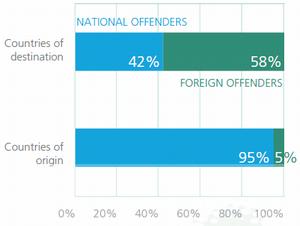
Source: UNODC elaboration on national data.
3. INCREASED DETECTION OF TRAFFICKING IN PERSONS FOR PURPOSES OTHER THAN SEXUAL EXPLOITATION
While a majority of trafficking victims are subjected to sexual exploitation, other forms of exploitation are increasingly detected. Trafficking for forced labour - a broad category which includes, for example, manufacturing, cleaning, construction, catering, restaurants, domestic work and textile production – has increased steadily in recent years. Some 40 per cent of the victims detected between 2010 and 2012 were trafficked for forced labour.
Trafficking for exploitation that is neither sexual nor forced labour is also increasing. Some of these forms, such as trafficking of children for armed combat, or for petty crime or forced begging, can be significant problems in some locations, although they are still relatively limited from a global point of view.
There are considerable regional differences with regard to forms of exploitation. While trafficking for sexual exploitation is the main form detected in Europe and Central Asia, in East Asia and the Pacific, it is forced labour. In the Americas the two types are detected in near equal proportions.
Forms of exploitation among detected trafficking victims, 2011*
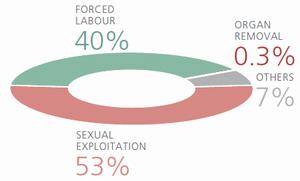
Source: UNODC elaboration on national data.
*Please note that the regional differences in detection capacities and definitions - particularly for forced labour - affect the global shares.
Share of the total number of detected victims who were trafficked for forced labour, 2007-2011

Source: UNODC elaboration on national data.
Forms of exploitation among detected trafficking victims, by region of detection, 2010-2012 (or more recent)
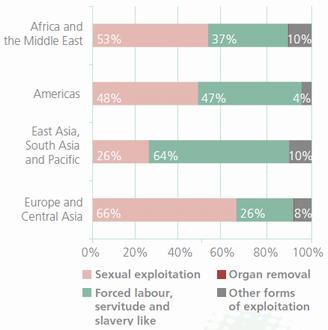
Source: UNODC elaboration on national data.
4. WOMEN ARE SIGNIFICANTLY INVOLVED IN TRAFFICKING IN PERSONS, BOTH AS VICTIMS AND AS OFFENDERS
For nearly all crimes, male offenders vastly outnumber females. On average, some 10-15 per cent of convicted offenders are women. For trafficking in persons, however, even though males still comprise the vast majority, the share of women offenders is nearly 30 per cent.
Moreover, approximately half of all detected trafficking victims are adult women. Although this share has been declining significantly in recent years, it has been partially offset by the increasing detection of victims who are girls.
Women comprise the vast majority of the detected victims who were trafficked for sexual exploitation. Looking at victims trafficked for forced labour, while men comprise a significant majority, women make up nearly one third of detected victims. In some regions, particularly in Asia, most of the victims of trafficking for forced labour were women.
Gender breakdown of detected victims of trafficking for forced labour, by region, 2010-2012 (or more recent)
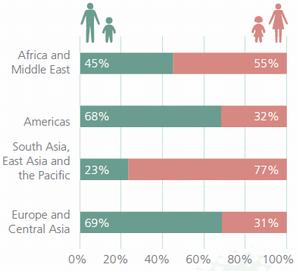
Source: UNODC elaboration on national data.
Persons convicted for trafficking in persons, by gender, 2010-2012 (or more recent)
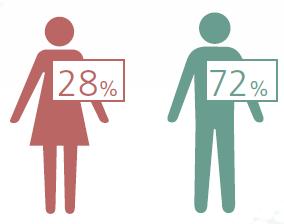
Source: UNODC elaboration on national data.
Trends in the shares of females (women and girls) among the total number of detected victims, 2004-2011
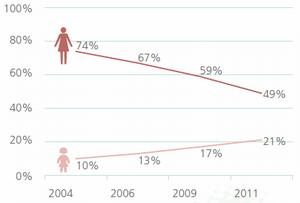
Source: UNODC elaboration on national data.
5. DETECTED CHILD TRAFFICKING IS INCREASING
Since UNODC started to collect information on the age profile of detected trafficking victims, the share of children among the detected victims has been increasing. Globally, children now comprise nearly one third of all detected trafficking victims. Out of every three child victims, two are girls and one is a boy.
The global figure obscures significant regional differences. In some areas, child trafficking is the major trafficking-related concern. In Africa and the Middle East, for example, children comprise a majority of the detected victims. In Europe and Central Asia, however, children are vastly outnumbered by adults (mainly women).
Trends in the shares of children (girls and boys) among the total number of detected victims, 2004-2011
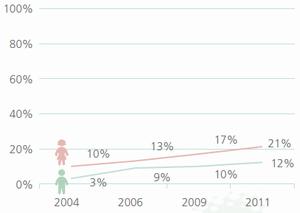
Source: UNODC elaboration on national data.
Shares of children and adults among the detected victims of trafficking in persons, by region, 2010-2012 (or more recent)
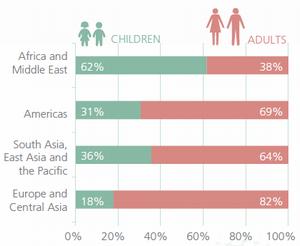
Source: UNODC elaboration on national data.
6. MORE THAN 2 BILLION PEOPLE ARE NOT PROTECTED AS REQUIRED BY THE UNITED NATIONS TRAFFICKING IN PERSONS PROTOCOL
More than 90 per cent of countries among those covered by UNODC criminalize trafficking in persons. Many countries have passed new or updated legislation since the entry into force of the United Nations Protocol against Trafficking in Persons in 2003.
Although this legislative progress is remarkable, much work remains. 9 countries still lack legislation altogether, whereas 18 others have partial legislation that covers only some victims or certain forms of exploitation. Some of these countries are large and densely populated, which means that more than 2 billion people lack the full protection of the Trafficking in Persons Protocol.
Criminalization of trafficking in persons with a specific offence, shares and numbers of countries, 2003-2014
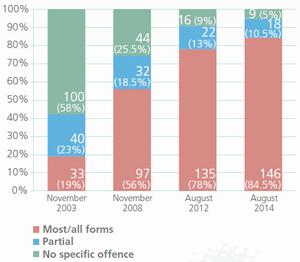
Source: UNODC elaboration on national data.
Criminalization of trafficking in persons with a specific offence, numbers of countries, by subregion, 2014
Source: UNODC elaboration on national data.
7. IMPUNITY PREVAILS
In spite of the legislative progress mentioned above, there are still very few convictions for trafficking in persons. Only 4 in 10 countries reported having 10 or more yearly convictions, with nearly 15 per cent having no convictions at all.
The global picture of the criminal justice response has remained largely stable in recent years. Fewer countries are reporting increases in the numbers of convictions which remain very low. This may reflect the difficulties of the criminal justice systems to appropriately respond to trafficking in persons.
Trends in the number of recorded convictions, share of countries
Sources: UN.GIFT/UNODC, Global Report on Trafficking in Persons 2009 (2003-2007); UNODC, elaboration on national data (2007-2010 and 2010-2012).
Number of convictions recorded per year, share of countries, 2010-2012
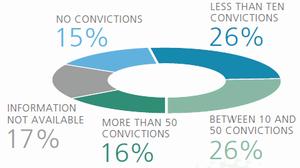
Source: UNODC elaboration on national data.
8. ORGANIZED CRIME INVOLVEMENT: TOWARDS A TYPOLOGY
Criminals committing trafficking in persons offences can act alone, with a partner or in different types of groups and networks. Human trafficking can be easily conducted by single individuals with a limited organization in place. This is particularly true if the crime involves only a few victims who are exploited locally. But trafficking operations can also be complex and involve many offenders, which is often the case for transregional trafficking flows.
Offenders may traffic their victims across regions to more affluent countries in order to increase their profits. However, doing so increases their costs as well as the risks of law enforcement detection. It also requires more organization, particularly when there are several victims. Cross-border trafficking flows – subregional and transregional – are more often connected to organized crime. Complex trafficking flows can be more easily sustained by large and well-organized criminal groups.
The transnational nature of the flows, the victimization of more persons at the same time, and the endurance in conducting the criminal activity are all indicators of the level of organization of the trafficking network behind the flow. On this basis, a typology including three different trafficking types is emerging. The trafficking types have some typical characteristics; however, as always, typologies are based on categorization to better explain and understand different aspects of trafficking. 'Pure' trafficking types may not exist since there is always some overlap between different types.
Typology on the organization of trafficking in persons
SMALL LOCAL OPERATIONS MEDIUM SUBREGIONAL OPERATIONS LARGE TRANSREGIONAL OPERATIONS Domestic or short-distance trafficking flows. Trafficking flows within the subregion or neighboring subregions. Long distance trafficking flows involving different regions. One or few traffickers. Small group of traffickers. Traffickers involved in organized crime. Small number of victims. More than one victim. Large number of victims. Intimate partner exploitation. Some investments and some profits depending on the number of victims. High investments and high profits. Limited investment and profits. Border crossings with or without travel documents. Border crossings always require travel documents. No travel documents needed for border crossings. Some organization needed depending on the border crossings and number of victims. Sophisticated organization needed to move large number of victims long distance. No or very limited organization required. Endurance of the operation.
INTRODUCTION
TRAFFICKERS, ORGANIZED CRIME AND THE BUSINESS OF EXPLOITATION
The crime of trafficking in persons is carried out by different types of traffickers, ranging from individuals exploiting their partner to organized criminal groups operating across national borders. Trafficking in persons is usually thought of as a 'transnational organized crime.' |1| And indeed, many trafficking outfits meet the criteria of transnational organized crime groups, as spelled out in the United Nations Convention against Transnational Organized Crime. |2| Aspects of the crime are often committed in different countries by criminals not necessarily hailing from the country where the crime was detected. These criminals may have organized themselves to a lesser or greater extent. In some cases the complexity of the crime requires a relatively high level of organization. In other cases, victims of trafficking in persons may have been trafficked by an individual trafficker operating in a local community.
In both cases, the profits that human trafficking can generate is the prime motivation for the criminals, and exploiting other people can be lucrative. Just as profit potential is an important consideration for most legitimate businesses, so it is for traffickers, who have a strong financial incentive to operate where profits are high. Broadly speaking, this means that traffickers will often choose to carry out the exploitation in a location where this will be more profitable. At the same time, traffickers also have to take into account costs and the risk of detection, which tends to increase as more territory and international borders are traversed.
This edition of the Global Report on Trafficking in Persons sheds light on the role of organized crime in trafficking operations, and presents a first step towards a typology of trafficking cases based on the level of organization of the crime as well as of the economic interests behind it. This work is in its infancy and will be further refined as more relevant information becomes available. |3| However, it can already shed some light on the more typical features of many trafficking cases, which will be helpful for designing appropriate responses to this crime.
What is trafficking in persons?
Trafficking in persons can be conceptualized in different ways. This Report employs the definition contained in the United Nations Trafficking in Persons Protocol. |4| According to this definition, which has been adopted by the 160 UN Member States that have ratified the Protocol, |5| there are three distinct 'constituent elements' of trafficking in persons: the act, the means and the purpose. All three elements must be present in order for a case to be defined as a trafficking in persons offence. Each element has a range of manifestations, however.
The Trafficking in Persons Protocol specifies that "the act" means the recruitment, transport, transfer, harbouring or receipt of persons. "The means" refers to the method used to lure the victim. Possible means are the threat or use of force, deception, coercion, abduction, fraud, abuse of power or a position of vulnerability, or giving payments or benefits. These terms are not necessarily precise from a legal point of view and may be defined differently by different jurisdictions. "The purpose" is always exploitation of the victim, though this can take on various forms, including sexual exploitation, forced labour, removal of organs or a range of other forms.
The Protocol definition is broad enough to give States Parties considerable leeway in tailoring and adapting their national legislation. This means that adjudicated trafficking crimes can look very different from one country to the next. Couple this with the fact that trafficking in persons affects nearly every country in the world, and the complexity of the trafficking crime is evident.
The Global Report on Trafficking in Persons
In July 2010, the United Nations General Assembly adopted the Global Plan of Action to Combat Trafficking in Persons. |6| The Global Plan was an expression of strong political will among Member States to tackle this heinous crime. Among its provisions was a request for an expanded knowledge base on trafficking in persons. As a result, UNODC was given the mandate and duty to collect data and report biennially on trafficking in persons patterns and flows at the national, regional and international levels.
Research by a global organization like UNODC brings the possibility of obtaining a 'bird's eye view' of the crime of trafficking in persons across the world. From an international perspective, and with data from many Member States in all regions of the world, it is possible to discern whether certain trafficking patterns or forms of exploitation are more prevalent in some areas, and whether certain trafficking flows are becoming more or less pronounced. Such knowledge also has the potential to enhance national-level responses as well as international cooperation in this area. Moreover, in this edition of the Global Report, it is also now possible to present some trend information which will further enhance the relevance and usefulness of the Report.
At present, there is no sound estimate of the number of victims of trafficking in persons worldwide. Due to methodological difficulties and the challenges associated with estimating sizes of hidden populations such as trafficking victims, this is a task that has so far not been satisfactorily accomplished. UNODC has consulted with leading researchers on hidden populations in order to generate recommendations for future research work to produce a global victim estimate; for more information, please refer to the text box 'Towards a global victim estimate?'.
METHODOLOGY
QUANTITATIVE DATA COLLECTION
The data collection for the Global Report on Trafficking in Persons has a dual objective: To achieve the broadest possible geographical coverage by using the most solid information available. While the geographical coverage is crucial for a report that is global in scope, the solidity of information is equally important as UNODC's intention is to produce a report that is reliable and accurate.
The statistical information was collected by UNODC in two ways: through a short, dedicated questionnaire |7| distributed to Governments and by the collection of official information available in the public domain (national police reports, Ministry of Justice reports, national trafficking in persons reports, et cetera). All the information that was collected, regardless of source or method, was shared with national authorities for verification prior to publication of this report.
Some countries were not covered by the data collection. These countries did not respond to the questionnaire, and in addition, UNODC research efforts to locate official national data on trafficking in persons did not yield any results.
Official statistics from national authorities account for 92 per cent of the information collected for this edition of the Global Report. Intergovernmental organizations supplied 5 per cent, and non-governmental organizations the remaining 3 per cent of the data.
DATA COVERAGE
The time period covered by the data is generally 2010-2012. Nearly 20 countries also provided information for the year 2013, and this is normally included in the analysis. Some trend presentations employ data collected for previous UNODC reports on trafficking in persons; in these cases, the sources are specified.
Data on offenders SUSPECTED PERSONS PROSECUTED PERSONS CONVICTED PERSONS Total number of reported offenders 33,860 34,256 13,310 Gender reported 29,568 10,024 4,915 Citizenship reported 5,747 Data on victims Total number of reported victims 40,177 Age reported 34,888 Gender reported 33,111 Age and gender reported 31,766 Citizenship reported 27,052 Countries of repatriation reported (for national victims trafficked abroad) 4,441 Form of exploitation reported 30,592 Gender reported according to form of exploitation 22,405 Reporting from Member States is not uniform. While the questionnaire provides a standard set of indicators, many countries report only partially. For example, some countries may provide citizenships for both offenders and victims, others for victims only, and yet others may only report the gender or age profile of the victims. As a result, the amounts of data that form the basis for the different analyses vary. Below is a breakdown of the data that countries reported to UNODC for each indicator.
These figures represent officially detected offenders and victims. These are persons who have been in contact with an institution – the police, border control, immigration authorities, social services, shelters run by the state or by NGOs, international organizations, et cetera - as a result of their involvement (or potential involvement in the case of suspect offenders, and persons in countries that report data on possible or probable victims of trafficking) in trafficking in persons situations. As for any crime, there is a large and unknown 'dark figure' of criminal activity that is never officially detected. As such, the figures reported here do not reflect the real extent of trafficking in persons, but rather a sample of the population of victims and offenders that is used to analyse patterns and flows of trafficking in persons.
In terms of geographical coverage, information has been collected from 128 countries for this edition of the Global Report. Specific country-level coverage is indicated in the table and map at the end of this section. All regions are covered, although the amount and solidity of the data varies between regions and subregions. Broadly speaking, Europe and Central Asia as well as the Americas have solid data coverage that allows for detailed analyses. Asia and the Pacific, and particularly Africa and the Middle East, are covered, but with significant room for improvement in terms of data quality and quantity.
All the information that was collected for and used in this Report is presented in the country profiles |8| which also specify the information sources.
QUALITATIVE DATA - THE 'COURT CASES'
As explained above, the main data source for the Global Report is statistical criminal justice data officially reported to UNODC by Member States. This data forms the basis for most of the analyses presented in the Report. However, in order to go beyond the statistics, for this edition of the Report, UNODC invited Member States to submit five cases of trafficking in persons that had recently been prosecuted in their jurisdiction. |9| Member States used their own discretion when selecting whether to contribute and which cases to include. This means that cases were not necessarily prosecuted under Trafficking in Persons Protocol-aligned legislation.
This call resulted in some 115 case briefs from nearly 30 different countries across six of the eight subregions used in the Report. These briefs will be referred to as the 'court cases' throughout the Report. About half of the cases were submitted by countries in Europe and Central Asia, and more than a quarter by countries in the Americas. Relatively few Asian and African cases were received.
The submitted material was not uniform, and there were often information gaps that made coding, comparison and analysis challenging. Moreover, the case sample is relatively small and not necessarily representative of the global manifestations of trafficking in persons. Therefore, it cannot be used to draw solid conclusions.
Regardless of the limitations, the wealth of information contained in these real-world cases can enrich our understanding of the patterns and flows of this crime. These cases illustrate some of the many ways in which trafficking in persons is planned and executed in diverse locations, and how criminal justice systems across many jurisdictions are tackling it. Information from the court cases will be presented alongside the quantitative data where relevant throughout the Report. When cases are discussed, the name of the submitting country is stated, but the names of other countries involved in the cases have been omitted.
ORGANIZATION OF THE REPORT
The report consists of two main analytical chapters. Chapter I provides a global overview of the patterns and flows of trafficking in persons. It also includes an extensive analysis of the role of organized crime elements in the trafficking crime, and an overview of the status of country-level legislation and responses to the trafficking crime. Chapter II analyses patterns and flows of trafficking in persons, as well as the responses to the crime, from a regional perspective. Additionally, the country profiles, which present the country-level information that was collected for this Report, are available on the Report website at www.unodc.org/glotip. These information sheets are divided into four main sections: the country's legislation on trafficking in persons; suspects and investigations; victims; and any additional information on the institutional response.
The 128 countries covered have been categorized into four regions: Europe and Central Asia, the Americas, South and East Asia and the Pacific, and Africa and the Middle East. The order of presentation is based on the size of the sample used for the analysis in each region, with Europe and Central Asia having the highest number of victims reported to UNODC during the period considered. The regional groupings are then further divided into two sub-regions when data coverage allows and doing so helps facilitate more extensive analysis. Europe and Central Asia consists of Western and Central Europe, as well as Eastern Europe and Central Asia. The Americas consists of North and Central America and the Caribbean, as well as South America. South Asia, East Asia and the Pacific consists of South Asia as well as East Asia and the Pacific. Africa and the Middle East consists of North Africa and the Middle East, as well as Sub-Saharan Africa.
Countries covered by the data collection for this report
Source: UNODC.
Note: The boundaries shown on this map do not imply official endorsement or acceptance by the United Nations. Dashed lines represent undetermined boundaries. The dotted line represents approximately the Line of Control in Jammu and Kashmir agreed upon by India and Pakistan. The final status of Jammu and Kashmir has not yet been agreed upon by the parties. The final boundary between the Sudan and South Sudan has not yet been determined.
Regional and subregional designations used in this report
Source: UNODC.
Note: The boundaries shown on this map do not imply official endorsement or acceptance by the United Nations. Dashed lines represent undetermined boundaries. The dotted line represents approximately the Line of Control in Jammu and Kashmir agreed upon by India and Pakistan. The final status of Jammu and Kashmir has not yet been agreed upon by the parties. The final boundary between the Sudan and South Sudan has not yet been determined.
AFRICA AND THE MIDDLE EAST 38 states out of the 66 UN Member States in the region
AMERICAS 29 states out of the 35 UN Member States in the region
EUROPE AND CENTRAL ASIA 43 states out of the 53 UN Member States in the region
SOUTH ASIA, EAST ASIA AND THE PACIFIC 18 states out of the 39 UN Member States in the region
North Africa and the Middle East (11 countries) Sub-Saharan Africa (total: 27) North and Central America and the Caribbean (total: 18) South America (total: 11) Western and Central Europe (total: 34) Eastern Europe and Central Asia (total: 9) East Asia and the Pacific (total: 12) South Asia (6 countries) Algeria Botswana Bahamas Argentina Albania Armenia Australia Bangladesh Bahrain Burkina Faso Barbados Bolivia (Plurinational State of) Austria Azerbaijan Brunei Darussalam India Egypt Cameroon Canada Brazil Bosnia and Herzegovina Belarus China Maldives Israel Cabo Verde Costa Rica Chile Bulgaria Kazakhstan Japan Nepal Jordan Central African Republic Cuba Colombia Croatia Republic of Moldova Malaysia Pakistan Lebanon Comoros Dominican Republic Ecuador Cyprus Russian Federation Myanmar Sri Lanka Morocco Democratic Republic of the Congo El Salvador Guyana Czech Republic Tajikistan New Zealand Qatar Gabon Grenada Paraguay Denmark Ukraine Philippines Tunisia Gambia Guatemala Peru Estonia Uzbekistan Republic of Korea United Arab Emirates Guinea-Bissau Haiti Uruguay Finland Samoa Yemen Kenya Honduras Venezuela (Bolivarian Republic of) France Thailand Lesotho Jamaica Germany Viet Nam Mauritania Mexico Greece Mozambique Nicaragua Hungary Namibia Panama Ireland Nigeria St. Vincent and Grenadines Italy Republic of Congo Trinidad and Tobago Latvia Rwanda United States of America Lithuania Senegal Malta Seychelles Montenegro Sierra Leone Netherlands South Africa Norway Swaziland Poland Togo Portugal Uganda Romania United Republic of Tanzania Serbia Zimbabwe Slovakia Slovenia Spain Sweden Switzerland The former Yugoslav Republic of Macedonia Turkey United Kingdom of Great Britain and Northern Ireland
CHAPTER I
GLOBAL OVERVIEWIn the United Nations Global Plan of Action to Combat Trafficking in Persons, |10| Member States requested for the present report to focus on the patterns and flows of trafficking in persons. 'Patterns' refer to the profiles of traffickers and victims; that is, their citizenship, age and gender as well as the forms of exploitation. 'Flows' refer to the geographic dimension of trafficking, with a 'flow' defined as one origin country and one destination country with at least five detected victims during the 2010-2012 reporting period. |11|
A snapshot of the data shows that most of the offenders are men, while most of the detected victims are female (mainly women, but also a significant number of underage girls). Trafficking is a transnational crime that is often carried out domestically or within a given subregion, and most offenders are convicted in their countries of citizenship. Victims, on the other hand, are often foreigners in the country where their exploitation was detected. Trafficking flows are usually confined to a geographically limited area, either within a country or between neighbouring or relatively close countries.
That said, a greater proportion of women are convicted of trafficking in persons than of nearly any other crime, and the detection of male victims is increasing. Many countries convict a significant number of foreigners of trafficking in persons, and many victims are not trafficked abroad but exploited in their own countries. Although transregional trafficking is less common than the domestic or intraregional types, it still accounts for nearly a quarter of all trafficking flows.
This chapter seeks to untangle some of this complexity. It will first present a global overview of patterns and flows, and then, a discussion on markets and organized crime as they relate to trafficking in persons. The chapter closes with an overview of the legislative and criminal justice responses to this crime across the world.
In order to understand the crime of trafficking in persons, it is crucial to know who the offenders are. Analysing the citizenship and gender of traffickers can help generate a broader understanding of the profiles of traffickers and their networks, as well as on how they operate. As trafficking in persons is a crime that is often transnational, the question of traffickers' citizenship is highly relevant, particularly when it comes to cross-border trafficking as there is often a citizenship link between traffickers and victims. Moreover, the issue of female involvement in trafficking in persons is also pertinent.
Information on the citizenship of persons convicted |12| of trafficking in persons was provided by 64 countries, covering a total of 5,747 offenders. Information on the gender of suspected, prosecuted and/or convicted offenders was provided by 43, 59 and 64 countries respectively, covering 29,568 persons suspected, 4,915 persons convicted of and 10,024 persons prosecuted for trafficking in persons. The data covers the 2010-2012 period (or more recent).
Citizenship profiles of traffickers
The aggregated citizenship profiles of the people convicted of trafficking in persons show that most offenders are citizens of the country where they were convicted. This is true for more than 6 in 10 convicted traffickers globally. It is reasonable to expect that the majority of people convicted of nearly any crime would be citizens of the prosecuting country. Even though international mobility is high, most people still live and operate mainly within their own countries.
While the majority of offenders are citizens of the country where they were convicted, about 35 per cent of convicted traffickers are foreigners in those countries. This is a larger share of convicted foreigners than what is typically seen for most other crimes, for which foreign citizens generally comprise approximately 10 per cent of those convicted. |13|
FIG. 1: Citizenship of convicted traffickers globally, 2010-2012 (or more recent); shares of local and foreign nationals (relative to the country of conviction)
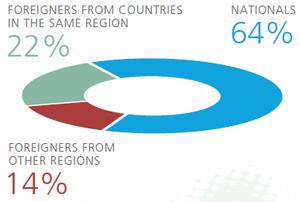
Source: UNODC elaboration on national data.
The high share of foreign involvement should not be surprising considering the often transnational nature of this crime. As will be presented later in the Report, about two thirds of the human trafficking victims reported to UNODC over the 2010 - 2012 period were exploited in cases that involved at least one border crossing.
When foreign offenders are involved, they tend to come from countries that are relatively close, geographically, to the prosecuting country. Some 22 per cent of those convicted of trafficking in persons are foreigners from countries within the region where they were prosecuted, while 14 per cent are citizens of countries in other regions. This means that in a given country in Asia, for example, it is reasonable to expect that most of the people convicted of trafficking in persons will be citizens of that country. The second largest group will be other Asians, and a relatively small share will be non-Asian foreigners.
This distribution largely follows the breakdown of global trafficking flows, as long-distance (transregional) trafficking is much less frequently detected than domestic or subregional trafficking. However, it should be noted that the share of convicted own citizens among the total number of trafficking offenders is generally much higher than the share of domestic trafficking detected in a given country. This could imply that domestic trafficking -which happens within the borders of one country - is mainly organized by citizens of that country.
MAP 1: Share of foreign offenders among the total number of persons convicted of trafficking in persons, by country, 2010-2012
Source: UNODC.
Note: The boundaries shown on this map do not imply official endorsement or acceptance by the United Nations. Dashed lines represent undetermined boundaries. The dotted line represents approximately the Line of Control in Jammu and Kashmir agreed upon by India and Pakistan. The final status of Jammu and Kashmir has not yet been agreed upon by the parties. The final boundary between the Sudan and South Sudan has not yet been determined.
Origin or destination country? In the context of discussing trafficking flows, the question of whether a given country is more of an origin or destination country is very relevant. Understanding whether a country 'sends' or 'receives' more trafficking victims is helpful for discerning transnational trafficking dynamics. It is not possible, however, to make a rigid distinction between origin and destination countries. As with any aggregation, such a broad categorization runs the risk of obscuring important details and highlighting observations that may not be accurate at the micro level. Moreover, domestic trafficking, which is detected in most countries across the world, makes countries origins and destinations simultaneously.
Even if only cross-border trafficking is considered, countries may belong to both categories. Indeed, most countries do, as they detect both outbound trafficking of own citizens and inbound trafficking of foreigners. Only a very few are exclusively origin or destination countries. For this reason, countries may be thought of as being more typical origin or more typical destination countries. While countries play both roles, the majority of the trafficking flows are either outbound (in the case of a more typical origin country) or inbound (more typical destination).
A more typical country of origin of cross-border trafficking may detect some foreign victims who are being exploited within its territory, but the outbound flow of that country's citizens for exploitation in other countries will be far larger.
Out of the 78 countries that provided information concerning the citizenship of the convicted offenders, 37 were considered to be more typical origin countries of cross-border trafficking, whereas 41 were considered more typical destination countries. While it should be kept in mind that the diverse national situations cannot be fully captured by such a broad categorization, when looking at the global level, classifying countries as more typical origin or destination countries of trafficking in persons is nonetheless very useful for trying to understand and describe typical cross-border trafficking flows.
But even so, local citizens are not only engaged in domestic trafficking. Many of those who were convicted in their own countries during 2010 – 2012 were taking part in cross-border trafficking, be it subregional or transregional. Convicted local citizens could be involved in both domestic and cross-border trafficking in some way, for example, as recruiters, transporters, guards or exploiters.
The court cases submitted to UNODC by Member States |14| include an illustrative case from Latvia, where two Latvian men were convicted of trafficking Latvian women to a different country in Western Europe for sexual exploitation. The offenders recruited the victims, deceived them regarding the working conditions they could expect in their destination country by promising a reasonable salary and reassuring them that they would not be involved in prostitution, and then transported the victims across the borders to accomplices. Once in the destination country, the victims were exploited in prostitution against very little pay. In this scheme, the offenders received money from their partners to cover their costs. From the available information, it seems that the convicted men were 'subcontracted' to recruit and transport victims for a larger, foreign-based operation. This shows how convicted persons reported as 'local offenders' may actually be involved in cross-border operations.
Though there are some differences, the overall pattern of offender citizenships in the case of cross-border trafficking holds true globally. But if a distinction is made between origin and destination countries for cross-border trafficking, the picture changes dramatically.
While countries that are more typically origin countries for cross-border trafficking convict mainly local citizens (about 95 per cent of all convictions), more typical destination countries convict fewer own citizens than foreigners of trafficking in persons (58 per cent foreigners, 42 per cent locals). Foreign participation is therefore a key characteristic of cross-border trafficking in persons in destination countries, but not in origin countries.
FIG. 2: Distribution of national and foreign offenders among countries of origin and destination of cross-border trafficking, 2010-2012
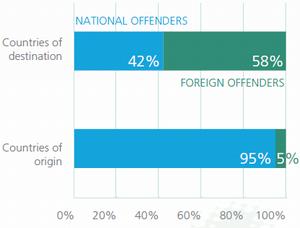
Source: UNODC elaboration on national data.
FIG. 3: Convictions of foreign citizens (relative to the convicting country) by countries of origin and destination of cross-border trafficking, 2010-2012
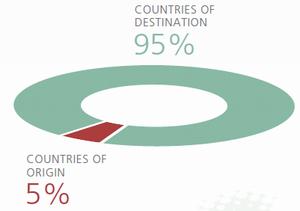
Source: UNODC elaboration on national data.
FIG. 4: Convictions of local citizens (relative to the convicting country) by countries of origin and destination of cross-border trafficking, 2010-2012
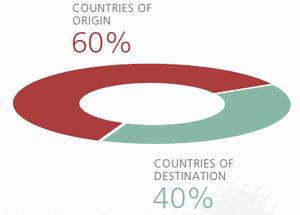
Source: UNODC elaboration on national data.
A qualitative analysis of the cross-border trafficking cases within the set of court cases shows that, while victims are normally recruited by local citizens in the victims' own country (origin country), the traffickers who carry out the exploitation in the destination country may be either local citizens of these destination countries or foreigners. Moreover, as shown in the chart above, 58 per cent of traffickers in destination countries are not citizens of the country where they were convicted. Only 5 per cent of all the traffickers convicted in origin countries are foreigners in these countries. While there is insufficient evidence to draw authoritative conclusions, on the base of the official data collected, it can be hypothesized that traffickers in destination countries are often able to recruit or maneuver local traffickers in origin countries.
A closer look at only the foreign citizens convicted of trafficking in persons shows that 95 per cent are convicted in destination countries. For local offenders, on the other hand, the distribution between origin countries and destinations is relatively equal. In other words, national offenders convicted of trafficking in persons may be found in origin and destination countries in similar proportions.
These findings seem to indicate that while recruitments in origin countries are largely carried out by citizens of those countries, the exploitation schemes in destination countries are likely to involve more transnational operators.
Many foreign traffickers also seem to frequently traffic victims from their own country of citizenship. This is confirmed by a clear statistical correlation between the citizenships of victims and offenders in selected destinations of cross-border trafficking. Moreover, in the court cases, many of the case briefs indicated that the citizenships of both trafficker(s) and victim(s) matched. This was particularly apparent when the offender was prosecuted in the destination country for the act of recruitment (sometimes also other acts). This indicates that ethno-linguistic affinities and specific local knowledge may be very useful for traffickers in recruiting their victims.
Gender profiles of traffickers
An analysis of potential offenders' first contact with the criminal justice system – the time of suspicion and/or investigation but before prosecution – shows that 38 per cent of suspected offenders were women during 20102012. This is another anomaly in comparison to other types of crime. While the majority, some 62 per cent, of suspected traffickers are male, the female share is large. These shares are similar, though somewhat smaller, at other stages of the criminal justice process as well: 32 per cent of prosecuted and 28 per cent of convicted traffickers are women. For most other crimes, the share of females among the total number of convicted persons is in the range of 10-15 per cent. |15| Relatively high female involvement appears to be another characteristic of the crime of trafficking in persons.
FIG. 5: Suspected trafficking offenders coming into first contact with the criminal justice system, by gender, 2010-2012 (or more recent)
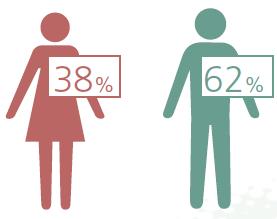
Source: UNODC elaboration on national data.
When looking at the gender and age of offenders and victims, for the period 2007-2010, countries with high rates of female offending were generally countries where many underage female (girl) victims were detected. This could indicate that female traffickers are more frequently involved in the trafficking of girls. |16|
One possible explanation for the high female involvement in this crime is that women might play different roles in the trafficking process; roles that may be more visible and therefore more easily detected by law enforcement. Perhaps women are more frequently used as recruiters, particularly in cases of trafficking for sexual exploitation, as they may be more easily trusted by other females. Women may also be more likely to be assigned roles as guards, money collectors and/or receptionists in places where exploitation takes place. These 'low-ranking' activities are often more exposed to the risks of detection and prosecution. |17| In addition, the roles of women in the human trafficking process often seem to be those that require frequent interaction with victims. This can increase the risk of detection for female offenders since many investigations of trafficking in persons cases rely heavily on victims' testimonies.
FIG. 6: Persons prosecuted for trafficking in persons, by gender, 2010-2012 (or more recent)
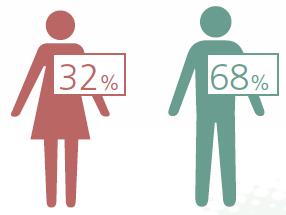
Source: UNODC elaboration on national data.
FIG. 7: Persons convicted of trafficking in persons, by gender, 2010-2012 (or more recent)
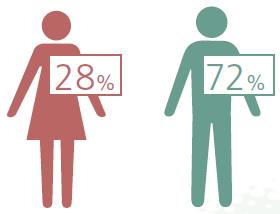
Source: UNODC elaboration on national data.
Another factor may be that a relatively high proportion of trafficking cases seems to involve intimate partner and/ or family relations. This was seen in the court cases, where convictions of intimate partners or two or more people in close family relationships were reported from several countries.
Intimate and/or close family relationships and trafficking in persons offending One of the characteristics of the crime of trafficking in persons is the large extent of female involvement. Not only do women and girls comprise the vast majority of detected victims worldwide, but women are also prosecuted and convicted of the trafficking crime far more often than for most other types of crime. Some 30 per cent of convicted traffickers worldwide between 2010 and 2012 were women, whereas the average female conviction rate for other crimes is usually in the region of 10-15 per cent.
Offending linked to intimate relationships, as well as close family relationships (parent-child or siblings), may be a factor in explaining why female offending is higher for trafficking in persons than for other crimes. In the court cases submitted to UNODC by Member States (some 115 cases submitted by nearly 30 different countries), there were many cases that saw convictions of couples, and some that involved mother-daughter pairs or siblings. While there were more men than women among the total number of convicted traffickers, the proportion of women offenders who were convicted alongside an intimate partner or close family member was larger than for men.
Several of the court cases that involved couples were transnational and involved trafficking of women for sexual exploitation. In these cases, the couples often lived in a destination country, and either one or both of the spouses were citizens of an origin country. Victims were usually recruited from the origin country, by the person with background from that country, and then transported for exploitation in the couple's adopted country. The offenders generally collaborated in the exploitation; the person who carried out the recruitment did not limit his/her participation to that phase of the crime. Such cases were reported from several destination countries.
For example, in one court case reported by Denmark, a couple with background from an East Asian country was convicted of trafficking four women from their origin country for sexual exploitation in Denmark. The female partner travelled to her origin country to carry out the recruitment; a task made easier by her prior experience working in the sex industry in her new country. The case notes confirm that the partners took equal part in the offence, and they received the same sentence, which included a permanent entry ban from their adopted country.
Similar cases have been registered in many countries around the world. These cases could be either domestic or transnational. One of the transnational court cases, submitted by Belarus, saw the conviction of a couple for trafficking six women from that country into sexual exploitation in a country in Western and Central Europe. Both perpetrators received 5-year prison sentences. One of the offenders was a citizen of Belarus, and the other, of the country where the exploitation took place. There were also other accomplices who were charged in separate cases. The victims were recruited through deception and subsequently 'sold' to owners of nightclubs in the receiving country.
While there were more cases of sexual exploitation in the court cases, couples and close family members also carry out trafficking for forced labour, as in a case from Mexico that saw the conviction of two women who were related. Together, they trafficked eight children from their native country to a neighbouring country for exploitation in forced labour. The children were made to clean car windshields and sell flowers, with the traffickers taking away the profits of their work. Moreover, an Israeli case saw an elderly couple convicted of trafficking for forced labour. They exploited their foreign housekeeper by making her work excessive hours, controlling her movements and not permitting breaks or holidays. The two perpetrators both received 4-month prison sentences. Although women offenders seem to be more frequently involved in trafficking for sexual exploitation, they also partake in trafficking for forced labour. The cases suggest that female offending is often linked to close personal relationships.
FIG. 8: Persons convicted of trafficking in persons, by gender and (sub)region, 2010-2012
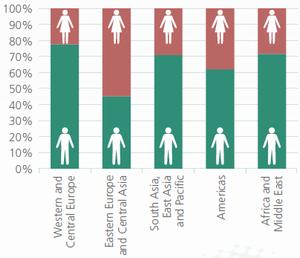
Source: UNODC elaboration on national data.
There are some regional differences in terms of the gender breakdown of persons prosecuted for and convicted of trafficking in persons. Female offending rates in Eastern Europe and Central Asia are higher than the global average. Africa and the Middle East, as well as the subregion of Western and Central Europe, report relatively low shares of convicted female offenders.
An analysis of the profiles of detected trafficking victims over the 2010-2012 period confirms the broad pattern reported previously by UNODC |18| covering the 2003-2010 period. The vast majority of the victims detected globally are females; either adult women or underage girls. The overall profile of trafficking victims may be slowly changing, however, as relatively fewer women, but more girls, men and boys are detected globally.
Information on the age and gender of trafficking victims was provided by 80 countries. It covers a total of 31,766 victims detected between 2010 and 2012 whose age and gender were reported.
FIG. 9: Detected victims of trafficking in persons, by age and gender, 2011
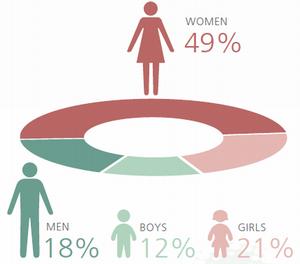
Source: UNODC elaboration on national data.
Adult women continue to comprise the largest group of detected victims, as approximately half of the total number are women. Although this is a large proportion, it has decreased markedly, which is in line with the trend reported in previous editions of this Report. This reduction in the number of women is partially offset by the increasing detection of girls, who now comprise around one fifth of the total number of detected victims worldwide. As a result, while the proportion of detected female victims is clearly decreasing, it is not decreasing as steeply as the trend for adult women.
During the 2010-2012 period, the share of males among the total number of victims detected globally ranged between 25 and 30 per cent. This is an increase compared to the years 2006 and 2009. The trend of underage boy victims has increased since 2004. While increases can be seen for both men and boys, it is more pronounced for men. The key reason seems to be the greater number of detected cases of trafficking for forced labour in many countries, as this type of trafficking involves more male than female victims.
The previously reported trend of an overall lowering of the average age of detected victims has been confirmed by the data collected for this Report. Child trafficking, in which victims are below 18 years of age, accounts for more than 30 per cent of the total number of victims detected during the 2010-2012 period. The proportion of detected child victims has increased significantly in recent years.
Towards a global victim estimate? The question of the magnitude of the trafficking problem – that is, how many victims there are – is hotly debated as there is no methodologically sound available estimate. In December 2013, UNODC hosted a meeting with academics and researchers with experience in uncovering various 'hidden populations'. The objective of the meeting was to obtain an overview of successful methodologies in enumerating hidden populationsI and to discuss research methods on trafficking in persons, with particular emphasis on the potential development of a global victim estimate.
The experts encouraged UNODC to avoid generic global or regional extrapolations based on weak methodologies. The data currently available to UNODC and the complexity of the phenomenon do not support the development of a reliable global victim estimate based upon a sound methodology. In order to start filling the data gaps, which are particularly acute in developing countries, the experts concluded that:
1. UNODC could initiate a series of small field studies to be conducted at local levels in different parts of the world. Such studies may only be considered as representative of the specific geographical realities and for the specific forms of trafficking considered.
2. Such studies should be based on a multiple steps approach:
- Conduct preliminary assessment and literature review of the forms of trafficking in persons and exploitation (sexual, labour, begging, domestic servitude, et cetera) occurring in the region concerned, and thus focus the field work on the most relevant.
- Define strict geographical boundaries.
- Carefully define tight indicators for trafficking in persons that are appropriate for the local realities and the forms of trafficking under consideration.
- Design modular questionnaires for different sub-populations.
- Identify the best sampling designs for the population considered and endeavour to use multiple validating approaches (respondent-driven sampling, geo-mapping, network scale-up, capture-recapture).
- Participate in the field studies.
Once a critical mass of small studies has been completed, a more comprehensive assessment of the severity of trafficking in persons may be carried out.
Additionally the experts encouraged UNODC to try to take advantage of existing data collection vehicles by making efforts to have relevant trafficking in persons-related questions included. This is particularly relevant for industrialized countries as these often carry out various national surveys with some regularity. There are also some United Nations-led surveys that could be used similarly.
Generating a methodologically sound estimate of the global number of trafficking victims is a commendable objective. Achieving it, however, would require significant resources and a long-term perspective.
I Further information on the research methodologies and approaches discussed at the expert meeting can be found in the next edition of the UNODC journal Forum on Crime and Society (forthcoming 2015). The meeting participants were: Kelle Barrick (RTI – Research Triangle Institute, United States), Jan van Dijk (Tilburg University, the Netherlands), Peter van der Heijden (Utrecht University, the Netherlands/ University of Southampton, United Kingdom), John Picarelli (United States Department of Justice), Michael 'Trey' Spiller (Centers for Disease Control and Prevention, United States), Thomas M. Steinfatt (University of Miami, United States), Ieke de Vries (National Rapporteur on Trafficking in Human Beings and Sexual Violence against Children, the Netherlands) and Sheldon X. Zhang (San Diego State University, United States).
However, increasing shares of children among the detected victims were not witnessed across all regions or areas. While Africa and the Middle East, North and Central America, as well as some countries in South America did register clear increases during the 2010-2012 period, in other regions of the world, such as Europe and Central Asia as well as South Asia, East Asia and the Pacific, child trafficking remained relatively stable compared to the 2007-2010 period.
The patterns of trafficking in persons continue to show pronounced regional differences. Children comprise the majority of victims detected in Africa and the Middle East, accounting for more than 60 per cent of the victims in this region. In Europe and Central Asia, trafficking in persons mainly concerns adult victims, as they comprise 83 per cent of the victims detected there. South Asia, East Asia and the Pacific and the Americas report similar age profile breakdowns, with adults comprising about two thirds of the detected victims, with children making up the remaining one third.
FIG. 10: Trends in the shares of females (women and girls) among the total number of detected victims, 2004-2011

Source: UNODC elaboration on national data.
FIG. 11: Trends in the shares of males (men and boys) among the total number of detected victims, 2004-2011
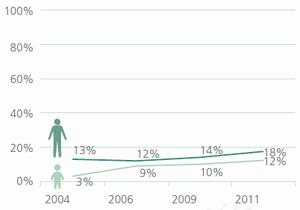
Source: UNODC elaboration on national data.
FIG. 12: Trends in the shares of children (girls and boys) among the total number of detected victims, 2004-2011
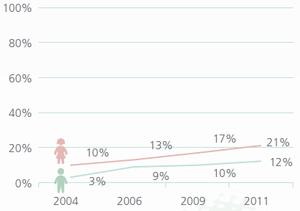
Source: UNODC elaboration on national data.
FIG. 13: Shares of children and adults among the detected victims of trafficking in persons, by region, 2010-2012
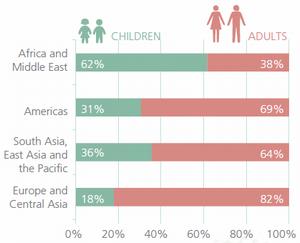
Source: UNODC elaboration on national data.
Recruitment through feigned romantic relationships The recruitment of victims is an essential part of the trafficking process. Though the recruitment can happen in many ways, it often involves deception. The victim may be deceived about work conditions such as the type of job, the workplace and the salary. In other cases, criminals deceive by feigning a romantic interest and entering into a relationship with the victim in order to gain her trust. Victims of this type of recruitment are often underage, but may also be adults. Generally, the perpetrator is male and the victim female. As the 'relationship' develops, the exploiter manipulates and/or coerces the victim into sexual exploitation, from which he obtains the profits.
This type of recruitment has been denounced by the Dutch authorities for more than a decade.I However, feigned romantic relationships is a relatively common recruitment method in many countries. The court cases submitted to UNODC by Member States included several clear cases of such recruitments, and even more where this method may have been used, but the information is insufficient to establish with certainty. While most of these cases originated from countries in the Americas, there were also cases from other parts of the world.
Many of the court cases involved domestic trafficking situations where one man recruited one victim, often an underage girl. In one case from Mexico, for example, a man met his 16-year-old victim at the video game parlour where she worked. He courted her, they began dating, and eventually moved together to a different city. Once there, he forced her into prostitution and took away the money paid by the customers. He also threatened and beat her. In this case, the offender was acting alone, and he was sentenced to nine years' imprisonment.
In another court case, reported by Canada, 10 males - including one minor boy - were convicted of trafficking four underage girls. The sentences ranged from one to three years of imprisonment. The offenders were part of a 'street gang' who carried out a relatively extensive trafficking operation in which the minor boy was the recruiter. He operated at schools were he could easily make contacts with multiple underage girls. Some of the girls fell in love with him and once trust had been established, the girls were introduced to the other, older gang members. The victims were then forced, under threats of violence, to abide by strict rules and provide sexual services for payments the traffickers then collected. Here, the recruitment through the feigned romantic relationship was one part of a larger scheme to exploit several girls.
This type of recruitment does not necessarily have to occur in a domestic context, however. In a court case from Brazil, a European man was found guilty of recruiting a local woman in Brazil through a feigned romantic relationship for the purpose of bringing her to Europe for sexual exploitation. The offender pretended that he was in love with the victim, gained her trust, arranged the travel and even paid for her passport. But once they arrived in Europe, the victim was locked in, forced to work as a prostitute and generate a set amount of money for the trafficker each day. The trafficker was sentenced to five years' imprisonment.
These cases show that recruitment through feigned romantic relationships can be used either by traffickers operating alone, or as part of a larger group. The exploitation can take place domestically or in another country, and although there were no such cases within the set of court cases, it is not inconceivable that this recruitment method could also be used to deceive potential victims of trafficking for forced labour. Every trafficking case needs at least one victim and feigned romantic relationships is one of the ways criminals go about recruiting victims.
I See, for example, Trafficking in Human Beings, the First Report of the Dutch National Rapporteur, Bureau NRM, The Hague, November 2002.
MAP 2: Share of children among the total number of detected victims, by country, 2010-2012
Source: UNODC.
Note: The boundaries shown on this map do not imply official endorsement or acceptance by the United Nations. Dashed lines represent undetermined boundaries. The dotted line represents approximately the Line of Control in Jammu and Kashmir agreed upon by India and Pakistan. The final status of Jammu and Kashmir has not yet been agreed upon by the parties. The final boundary between the Sudan and South Sudan has not yet been determined.
Exploitation is the source of profits in trafficking in persons cases, and therefore, the key motivation for traffickers to carry out their crime. Traffickers, who may be more or less organized, conduct the trafficking process in order to gain financially from the exploitation of victims. The exploitation may take on a range of forms, but the principle that the more productive effort traffickers can extract from their victims, the larger the financial incentive to carry out the trafficking crime, remains.
Victims may be subjected to various types of exploitation. The two most frequently detected types are sexual exploitation and forced labour. The forced labour category is broad and includes, for example, manufacturing, cleaning, construction, textile production, catering and domestic servitude, to mention some of the forms that have been reported to UNODC. Victims may also be trafficked for the purpose of organ removal, or for various forms of exploitations that are not forced labour, sexual exploitation or organ removal. These forms have been categorized as 'other forms of exploitation' in this Report, and this Section will also examine the detections of these 'other forms' in some detail.
Information on the forms of exploitation was provided by 88 countries. It refers to a total of 30,592 victims of trafficking in persons detected between 2010 and 2012 whose form of exploitation was reported.
Looking first at the broader global picture, some 53 per cent of the victims detected in 2011 were subjected to sexual exploitation, whereas forced labour accounted for about 40 per cent of the total number of victims for whom the form of exploitation was reported.
FIG. 14: Forms of exploitation among detected trafficking victims, 2011
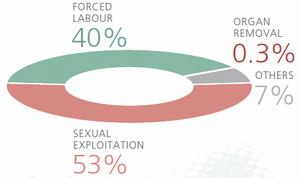
Source: UNODC elaboration on national data.
FIG. 15: Share of detected victims trafficked for forced labour, 2007-2011
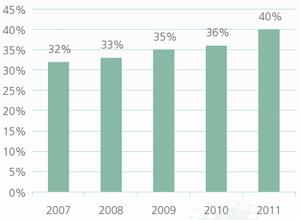
Source: UNODC elaboration on national data.
While among the detected trafficking victims, sexual exploitation is the largest category, the share of forced labour detections is increasing. The increasing detections of trafficking for forced labour has been a significant trend in recent years
Trafficking for sexual exploitation is the major detected form of trafficking in persons in Europe and Central Asia. More than 65 per cent of the victims detected in this region are trafficked for sexual exploitation. In the subre-gion of Eastern Europe and Central Asia in particular, sexual exploitation is frequently detected, accounting for 71 per cent of the victims (see also the regional overview).
In the other regions, the shares of trafficking for forced labour are far higher than in Europe and Central Asia. In South Asia, East Asia and the Pacific, trafficking for forced labour is the major detected form of trafficking as it accounts for nearly two thirds of the detected victims. In the subregion of South Asia, over 80 per cent of the reported victims are trafficked for forced labour (see the regional overview). In the Americas, trafficking for forced labour and trafficking for sexual exploitation are detected in nearly identical proportions.
There are some differences between the two subregions of the Americas, however. In North America, Central America and the Caribbean, more than 50 per cent of the detected victims are exploited in forced labour, whereas in South America, the percentage is around 40. The proportion of detected trafficking for forced labour in South America is a likely underestimation as this category does not include the large number of victims of 'slavery and slavery-like conditions'. These victims are not officially recorded as trafficking victims as it is unknown to which extent they are in exploitative situations as a result of a trafficking process. If the victims who are exploited under 'slavery or slavery-like conditions' |19| in South America would be considered trafficking victims, the share of victims of trafficking in persons for forced labour globally would be considerably larger.
FIG. 16: Forms of exploitation among detected trafficking victims, by region, 2010-2012 (or more recent)
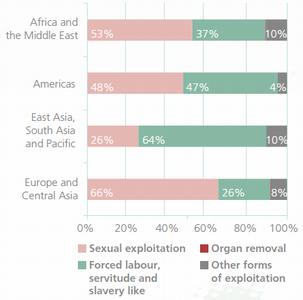
Source: UNODC elaboration on national data.
Globally, ten types of exploitation different from sexual exploitation, forced labour or organ removal were identified by the national authorities during the reporting period. These types are trafficking for mixed exploitation in forced labour and sexual exploitation, for committing crime, for begging, for pornography (including internet pornography), forced marriages, benefit fraud, baby selling, illegal adoption, |20| armed combat and for rituals.
MAP 3: Countries that report forms of exploitation other than forced labour, sexual exploitation or organ removal, 2010-2012
Source: UNODC.
Note: The boundaries shown on this map do not imply official endorsement or acceptance by the United Nations. Dashed lines represent undetermined boundaries. The dotted line represents approximately the Line of Control in Jammu and Kashmir agreed upon by India and Pakistan. The final status of Jammu and Kashmir has not yet been agreed upon by the parties. The final boundary between the Sudan and South Sudan has not yet been determined.
There are pronounced regional differences with regard to these 'other forms of exploitation'. While in Europe and Central Asia, this category mainly includes begging and victims trafficked to commit (often petty) crime, in Sub-Saharan Africa, it often entails trafficking of children for armed combat ('child soldiers'). In Asia, the issue of forced marriage is also frequently reported for victims who are not trafficked for sexual exploitation, forced labour or organ removal.
During the reporting period, cases of trafficking for organ removal were detected and reported by 12 countries. These victims account for about 0.2 per cent of the total number of victims. Most of the detected victims of this form of trafficking are males.
In general, the profiles of the victims of trafficking reflect the types of trafficking that are more commonly detected in different parts of the world. The observed correlation between the profile of the detected victims and the type of exploitation is only partial, however, and an analysis of the profiles commonly associated with the different types of trafficking reveals some significant nuances.
Globally, the vast majority of detected female victims are trafficked for sexual exploitation, whereas most of the detected male victims are trafficked for forced labour.
However, a closer look at the broad category of trafficking for forced labour reveals that this is not a crime that only involves male victims. In fact, about one third of the total number of victims detected globally who were trafficked for forced labour are females, and about two thirds are males. In other words, females are also trafficked for forced labour in significant numbers.
An analysis of the regional differences shows that in Africa and the Middle East, as well as in South Asia, East Asia and the Pacific, females account for the majority of the detected victims trafficked for the purpose of forced labour. Although the data coverage for these vast regions is relatively poor, which makes it difficult to draw strong conclusions, exploitation in domestic labour – which often affects women |21| - may be one of the explanations. This form of trafficking has been reported relatively frequently from some areas within these regions.
FIG. 17: Forms of exploitation among detected female and male trafficking victims, 2010-2012 (or more recent)

Source: UNODC elaboration on national data.
FIG. 18: Gender breakdown of detected victims of trafficking for forced labour, 2010-2012 (or more recent)
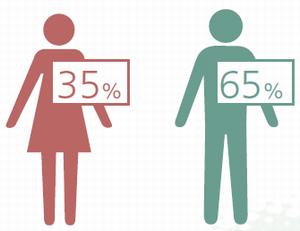
Source: UNODC elaboration on national data.
FIG. 19: Gender breakdown of detected victims of trafficking for forced labour, by region, 2010-2012 (or more recent)
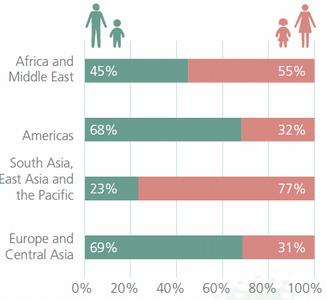
Source: UNODC elaboration on national data.
Females are also frequently detected as victims of trafficking for forced labour in Europe and Central Asia and in the Americas, although not as frequently as males. In these two regions, females comprise approximately one third of the victims of this type of trafficking.
Looking at trafficking for sexual exploitation, the vast majority of the detected victims are females. Nonetheless, trafficking of males for the purpose of sexual exploitation does exist and it is not negligible. About 3 per cent of the total number of victims of trafficking for sexual exploitation detected between 2010 and 2012 are males. Looking only at the detected male victims (all types of exploitation), some 8 per cent are exploited in the sex industry. About one fifth of male victims were subjected to 'other' types of exploitation.
In the case of trafficking of males for sexual exploitation, the exact proportion among the total number of detected victims varies significantly between regions. It is, however, relatively low across all regions, ranging between 2 and 5 per cent. In Africa and the Middle East, the share is in the lower end of the range, whereas it is higher in Europe.
The share of detected victims exploited in trafficking for forms other than sexual exploitation, forced labour or organ removal has increased from 3 per cent in 2006 to 6 per cent in 2010 and 7 per cent in 2011 worldwide. Between 2010 and 2012, some 60 per cent of the victims falling into this category were women or girls. The broad 'other forms' category includes very different types of trafficking in persons that often involve victims with different profiles. Trafficking for forced armed combat - or child soldiers - targets mainly boys. Mixed forms of labour and sexual exploitation mainly affects women, whereas forced marriages usually involve victims that are girls or young women. Trafficking for begging and/or committing petty crime mainly involves children, both girls and boys, as does trafficking for the production of pornographic material. For some other forms of exploitation, including for fraudulent state benefit claims and other purposes not listed here, the profile information is not known.
FIG. 20: Gender breakdown of detected victims of trafficking for sexual exploitation, 2010-2012 (or more recent)
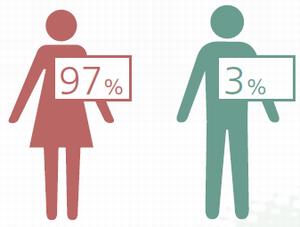
Source: UNODC elaboration on national data.
FIG. 21: Gender breakdown of detected victims of trafficking for 'other' forms of exploitation than forced labour, sexual exploitation or organ removal, 2010-2012 (or more recent)
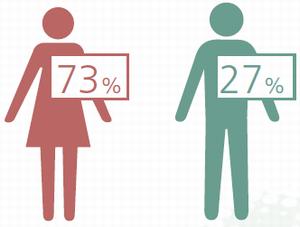
Source: UNODC elaboration on national data.
Trafficking in persons is a crime of global scope that leaves virtually no country unaffected. An analysis of the geographic dimension of this crime, that is, where victims are trafficked to and from, can help in identifying and monitoring acute situations and inform the prioritization of anti-trafficking efforts. Information regarding the citizenships of detected victims in their destination countries is crucial for mapping the trafficking flows, and many Member States were able to provide such information to UNODC. In addition, data regarding the destination countries of victims who have been repatriated to their own (origin) countries can also shed light on trafficking flows. Analyses stemming from such data is presented separately.
Information regarding the citizenships of victims was provided by 83 countries. It refers to a total of 27,052 victims of trafficking in persons detected between 2010 and 2012 (or more recently) whose citizenship was reported. With regard to repatriation, information was provided by 35 countries, covering 4,441 own citizens (relative to the reporting countries) who had been repatriated by other countries where they had been detected as victims of trafficking.
The broad geographical dispersion of victim detections is well known. Between 2010 and 2012, victims with 152 citizenships were detected in 124 countries across the world. At least 510 trafficking flows |22| were detected globally. This should be considered an absolute minimum as it is based on official data reported to UNODC which does not include the hidden cases of trafficking; the actual number of flows is likely to be significantly higher.
Victims can be trafficked either domestically (within the borders of one country |23|) or transnationally (crossing at least one border between different countries). About 70 per cent of the detected victims over the 2010-2012 period were trafficked cross-border. However, only 27 per cent of the total number of victims experienced transregional trafficking; that is, being trafficked from one region to another. While most detected cases of trafficking are transnational – meaning that they implicate more than one country and at least one border crossing - they are usually also of limited geographical reach (they often happen within the same subregion).
FIG. 22: Breakdown of trafficking flows by geographical reach, 2010-2012 (or more recent)
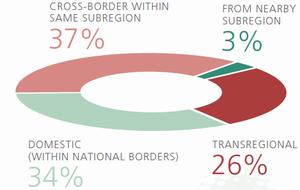
Source: UNODC elaboration on national data.
As will be discussed later in the section on Traffickers, organized crime and the business of exploitation, intraregional trafficking – which is the most commonly detected type - often sees victims from relatively poorer countries within a given geographical area being exploited in relatively richer ones. Similarly, although UNODC does not collect this information systematically, information from the court cases submitted by Member States suggests that domestic trafficking often involves victims from relatively poorer areas of the given country trafficked for exploitation into more affluent areas; often the capital or another large city.
Transregional trafficking comprises about 27 per cent of the total number of detected trafficking flows, and these flows provide the clearest illustration of the distinctions between origins and destinations. Victims of this type of trafficking are more often detected in the affluent areas of the Middle East, Western Europe and North America, although there are also some transregional trafficking flows with destinations in other areas.
A key feature of transregional trafficking is the complexity of carrying it out. To traffic someone across continents, offenders generally need valid passports, visas or other permits to allow entry into the destination country, international transportation, local transportation in both the sending and receiving countries, lodging, supervision of the victim during the travel and a way to collect and control the victim upon arrival at destination, before the exploitation commences. While it may be possible for a single offender to traffic one or two victims alone, it is often necessary to involve others to varying extents. Setting up a transregional trafficking operations also often require more skills and capital than starting a more geographically confined scheme.
In one court case, submitted by the United States of America, an Eastern European criminal group with at least five members (who were brothers) trafficked victims from their country into the United States and exploited them in forced labour. The traffickers evaded US visa requirements by having the victims travel to a neighbouring country on tourist visas and then arranging for them to be smuggled into the United States. Once in the United States, the victims had to be transported, lodged and controlled. Their passports were taken away and they were made to work as cleaners and janitors in various large commercial properties. While such a trafficking operation may generate considerable profits, it also requires a lot of skills, capital and labour to set up and run. Two of the group members have so far been convicted; one received a prison sentence of life plus 20 years, and the other, 20 years' imprisonment.
Domestic trafficking, on the other hand, tends to require less preparation and organization. There is no need for travel documents and costly flight tickets, and transport – if necessary – can often be easily arranged by private car. Moreover, traffickers may not need to acquire special lodging for the victims as they may use their own residence or place of business. There were several instances of such arrangements in the court cases, for example, one case from El Salvador where a woman was convicted of trafficking one girl for sexual exploitation. The girl was recruited with a promise of cashier work in the offender's shop, but was instead locked up in the shop, threatened, starved and forced to drink alcohol in order for men to exploit her sexually against payment to the trafficker. In comparison to the transregional trafficking operation described above, the preparation and management in this case is minimal, but the profit potential also pales in comparison. The investments of traffickers into the trafficking process seem to be related to the expected profits as the traffickers aim at maximizing their return - as in any other business.
MAP 4: Shares of detected victims who are trafficked into the given country from another subregion, 2010-2012
Source: UNODC.
Note: The boundaries shown on this map do not imply official endorsement or acceptance by the United Nations. Dashed lines represent undetermined boundaries. The dotted line represents approximately the Line of Control in Jammu and Kashmir agreed upon by India and Pakistan. The final status of Jammu and Kashmir has not yet been agreed upon by the parties. The final boundary between the Sudan and South Sudan has not yet been determined.
MAP 5: Shares of detected victims by subregional and transregional trafficking, 2010-2012
Source: UNODC.
Note: The boundaries shown on this map do not imply official endorsement or acceptance by the United Nations. Dashed lines represent undetermined boundaries. The dotted line represents approximately the Line of Control in Jammu and Kashmir agreed upon by India and Pakistan. The final status of Jammu and Kashmir has not yet been agreed upon by the parties. The final boundary between the Sudan and South Sudan has not yet been determined.
FIG. 23: Citizenships of foreign victims, by subregion, shares of the total number of detected victims, 2010-2012
Source: UNODC elaboration on national data.
MAP 6: Main destination areas of transregional trafficking flows (in blue) and their significant origins, 2010-2012
Source: UNODC.
Note: The boundaries shown on this map do not imply official endorsement or acceptance by the United Nations. Dashed lines represent undetermined boundaries. The dotted line represents approximately the Line of Control in Jammu and Kashmir agreed upon by India and Pakistan. The final status of Jammu and Kashmir has not yet been agreed upon by the parties. The final boundary between the Sudan and South Sudan has not yet been determined.
Looking specifically at transregional trafficking, the Middle East |24| registers the highest share of inbound trafficking from other regions. More than half of the victims detected in that area were trafficked from other regions. For Western and Central Europe and North and Central America and the Caribbean, this was true for about 40 per cent of the detected victims. The origins of victims involved in transregional trafficking flows are also very diverse, with victims coming from countries in most other regions.
The other regions and subregions are very different and hardly report transregional trafficking. The shares of domestic and intraregional trafficking in these regions are above 95 per cent. While there are relatively small shares of victims trafficked in from other regions in some of these countries, the overwhelming majority of the victims detected in East Asia are citizens of other East Asian countries, in South Asia they are mainly South Asians, in Africa they are generally Africans and so forth.
Considering the dispersion of victims from different areas, it is clear that some origin areas have a global dimension, where victims from that particular area are trafficked widely across the world. Other areas are more regional, and some predominantly domestic. East Asian victims belong in the first category.
Victims from East Asia have been detected in all regions and subregions of the world; often in significant numbers. East Asians – particularly South-East Asians – have been detected in and/or repatriated from the most geographically dispersed set of destination countries of any geographical aggregation of victims. This is largely because East Asian victims have been detected in and/or repatriated from the highest number of destination countries outside that region, particularly in North America, the Middle East and Western and Central Europe.
Victims from the subregion of Eastern Europe and Central Asia have also been detected in and/or repatriated from a large number of countries. The difference is that victims from Eastern Europe and Central Asia are mainly detected within the broader region of Europe and Central Asia. Only a limited number of countries outside Europe report detecting victims who are citizens of countries in Eastern Europe and Central Asia, which means that trafficking originating in this area is highly relevant and widely spread across Europe, whereas East Asian trafficking is also transregional.
FIG. 24: Diffusion of trafficking flows within and out of the subregion of origin (number of countries where citizens of countries in the given subregions were detected), 2010-2012 (or more recent)
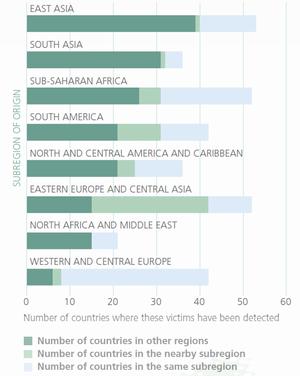
Source: UNODC elaboration on national data.
In addition to East Asia, other significant origin areas for transregional trafficking flows are South Asia (widely detected in the Middle East and North America), Sub-Saharan Africa (detected in Western and Central Europe) and South America (detected in Western and Central Europe, as well as in North and Central America). As previously mentioned, in Eastern Europe and Central Asia, South Asia, East Asia and the Pacific, South America and Sub-Saharan Africa, victims from outside the region in question are rarely detected.
Trafficking in persons and armed conflicts As other disasters, armed conflicts can have an impact on the level on trafficking in persons in affected communities. Conflicts increase the vulnerable populations, in connection for instance with the number of displaced people and refugees. Conflicts often cause decay of national institutions, generate gender imbalances in conflict zones, and create a demand for combatants. Mobility by itself creates vulnerabilities when people lose their support networks and face situations where the language and the management of everyday life are different. These are all factors that amplify trafficking flows originating from or destined to conflict areas. According to the information collected for this Report, during the period 2011-2013, eight countries in the world report having detected Syrian victims, while victims from this country were very rarely detected before the beginning of the Syrian turmoil in 2011. Most of these victims have been detected in the Middle East and in Western Europe. It can be assumed that this increase parallels the large numbers of displaced people and refugees escaping conflict areas (UNHCR reports that there are some 6.5 million Syrians who are internally displaced, and 2.5 million are refugees).I
Child soldiering is a form of trafficking that has been widely documented.II Most of the cases are reported from countries in Africa, where the different armed groups operating in Central and West Africa have been forcibly recruiting children to use them as combatants for decades. The number of victims detected are of concern. UNICEF reported in May 2014 that at least 6,000 children have been recruited by armed groups in the Central African Republic.III In the Democratic Republic of the Congo, the United Nations Organization Stabilization Mission documented the recruitment of 996 children over a 20-month period in 2012-2013.IV Victims are not only Congolese, but also children from neighbouring countries as these armed groups are mobile and operate across the entire Central African region.V Similar practices have been documented in this and previous Report editions during conflicts in Africa, different countries in the Middle East as well as in South America.
Conflicts may also create demand for victims of sexual exploitation. This is due to the situation where organized crime activities are often strengthened due to social degradation and the absence of rule of law. This may open the door to various human rights violations, including trafficking in persons for sexual exploitation. It has been documented how the stationing of troops, peacekeepers and stabilization forces (including those operating under the United Nations flag) in conflict and post-conflict zones may have fuelled the demand for girls and young women trafficked for sexual exploitation in some parts of the world.VI
I 2014 United Nations High Commissioner for Refugees (UNHCR) country operations profile - Syrian Arab Republic, Statistical snapshot as of January 2014, available at: http://www.unhcr.org/pages/49e486a76.html.
II See, for example, United Nations, Impact of Armed Conflict on Children - Report of Graga Machel, Expert of the Secretary-General of the United Nations. A/51/306, 26 August 1996; UNICEF, Machel Study 10-Year Strategic Review Children and Conflict in A Changing World, April 2009.
III UNICEF, Children in Crisis in Central African Republic – a Four Month Progress Report, May 2014.
IV MONUSCO (United Nations Organization Stabilization Mission in the Democratic Republic of the Congo), Child Recruitment by Armed Groups in DRC, October 2013.
V See, for example, United Nations, Report of the Secretary-General on the United Nations Organization Stabilization Mission in the Democratic Republic of the Congo, various reports covering the years 2010-2013 (available at: http://www.un.org/en/peacekeeping/missions/monusco/reports.shtml); United Nations, Report of the Secretary-General on children and armed conflict in the Democratic Republic of the Congo (S/2014/453), 2014; United Nations, Report of the Secretary-General on the situation in the Central African Republic (S/2013/787), 2013.
VI See, for example, United Nations, Special measures for protection from sexual exploitation and sexual abuse – Reports of the Secretary-General for the years 2003-2008 (A/58/777; A/59/782; A/60/861; A/61/957; A/62/890; A/63/720) ; United Nations, Activities of the Office of Internal Oversight Services on peacekeeping operations for the period from 1 January to 31 December 2012 – Report of the Office of Internal Oversight Services (A/67/297 (Part II)), 2013; Mendelson, S.E., Barracks and brothels: peacekeepers and human trafficking in the Balkans, Center for Strategic and International Studies, 2005.
TRAFFICKERS, ORGANIZED CRIME AND THE BUSINESS OF EXPLOITATION
The analysis of the patterns and flows has revealed that trafficking in persons is an intricate crime. The definition of trafficking in persons comprises a series of actions carried out by different actors, victimizing different persons in different ways by different means. On the surface, the children sold by their parents to work as street vendors or who are exploited in domestic servitude are very different from the transcontinental trade of women exploited in the commercial sex markets of Western Europe, migrants from Latin America exploited in agriculture in North America, or men exploited in the construction sector in the Middle East. What they do have in common is that they are victimized through a trafficking process.
Regions differ not only in terms of where the trafficking takes place or which trafficking patterns prevail. Within the same geographical area, victims may have been trafficked from a distant region, from a neighbouring country, or from a nearby village to be exploited in brothels or the catering industry, in agriculture or begging, or as domestic servants. All these forms and flows coexist everywhere in the world. However, while the suffering of the victims is the same, the trafficking organizations differ in line with the process required for bringing the victims into an exploitative situation.
In which ways are domestic and transregional trafficking different, and how are they similar? What is the role of organized crime in human trafficking, and how do traffickers operate? A qualitative analysis of the court cases submitted by Member States combined with a quantitative analysis of the profiles of victims and offenders will help to clarify and categorize different forms of trafficking.
Individual traffickers and organized groups
Non-organized domestic trafficking
As shown in some of the court cases, coercing one adolescent from the very same village or region for prostitution, for instance, can be easily conducted by one or two people. In the previously discussed case from El Salvador, the shop owner could easily deceive a young girl by taking advantage of her age to force her into sexual exploitation for his shop's clients. This is an example of the relative ease with which single individuals can victimize children. In this case, the recruitment method was simply a promise of a proper job in the shop. The shop owner was arrested and convicted in 2011 with a prison sentence of eight and a half years for trafficking in persons.
Similar cases are recorded everywhere in the world. In Europe, the Austrian authorities reported a court case of a young man from Central Europe who easily managed to deceive two young compatriots with a promise of a decent job in Austria. Once at destination, a relatively short drive from their home, the trafficker physically threatened them in order to force them into street prostitution. With the help of people passing by, the victims managed to escape, and the trafficker was convicted with a prison sentence of six years. A similar case was submitted by Canada, where a single individual started to exploit his girlfriend in prostitution. This local trafficker leveraged his power over the girl, and turned what had seemed like an intimate relationship into an exploitative situation. He received a five-year prison sentence.
Such cases do not always involve sexual exploitation, however. In another court case, submitted by Nigeria, a woman was convicted of recruiting two young boys by promising their parents that they would receive an education. But the boys were never put into school once they arrived at the woman's residence, which was far from their hometowns. Instead, they were made to work as street hawkers, giving all the profits to the trafficker, and they also had to do her domestic work. Moreover, the boys were not fed properly, and were also beaten on occasion. The trafficker was sentenced to two years' imprisonment.
Many other cases could illustrate how human trafficking can be easily conducted by single individuals with a limited organization in place. This is particularly true if it is conducted against one or a few victims exploited locally. In such cases, the individual traffickers and their victims are either citizens of the country where the exploitation takes place, or foreigners who have been living many years in that country or foreigners from a nearby location. These cases nearly always involve trafficking within the same country or between neighbouring countries, and a limited number of victims.
The fact that this type of trafficking is conducted by individuals acting independently does not mean it is uncommon. According to the data collected, domestic trafficking accounts for 34 per cent of the total number of detected victims, and trafficking conducted within countries belonging to the same subregion accounts for 37 per cent. Of course, not all are operated by individuals alone, but this is a phenomenon which may be a substantial part of domestic trafficking. A study conducted in Amsterdam shows that a vast majority of the cases of women trafficked for sexual exploitation there have some characteristics of dysfunctional intimate partner relations rather than an organized crime activity. In this study, the trafficker enjoys the revenues generated by the prostitution of his partner, and the girlfriend is subjugated to her pimp on the basis of her emotional relationship with him. |25|
Organized subregional trafficking
In contrast to individual traffickers, those traffickers who operate in an organized group |26| may be able to traffic more victims and to operate in different countries in a coordinated manner. A greater level of organization may enable the exploitation of more victims and thus higher revenues, especially when traffickers operate in wealthy countries.
One of the court cases reported by Norway involved an extended family group from another European country. Members of this group were found to have trafficked four young girls from within the extended family for exploitation through shoplifting, begging and the selling of fake gold jewellery. For one of the victims, the case also involved forced marriage and rape. Six perpetrators were convicted and received prison sentences ranging from one and a half years to three and a half years.
Many similar examples were found within the court cases, particularly with regard to trafficking for sexual exploitation. For example, Lithuania reported a case where five local citizens, who operated as a group, were convicted. This group specialized in recruiting mainly underage girls from Lithuania and other Baltic countries, with the purpose of selling them to other criminal groups for exploitation in Western Europe. The main activities of the convicted offenders were recruitment and transportation. This implied deceiving the victims and transporting them, by plane or car, to their destinations in several Western European countries. Here, the group sold the victims to other groups who would then force them into sexual exploitation. This clear transnational organized crime activity required connections with other groups, significant investments for travel and border crossing, and overall coordination and distribution of labour.
The transnational nature of these trafficking processes increases the risks of being arrested – whether for trafficking in persons or other offences – especially if the border crossings require control of travel documents. In the case above, such an elaborate organization would not have been required if the victims were exploited within the national border or in a neighbouring Baltic country, and the detection risk would have been lower.
The cases discussed above refer to trafficking episodes that took place within the same subregion, that is, within a limited geographical range. Nonetheless, they show that this type of trafficking may require an organized network, especially if this entails trafficking more victims across the borders with exploitation taking place over an extended period of time.
Organized transregional trafficking
Some trafficking cases require substantial levels of organization. Israel, for example, reported a court case of a trafficking ring that moved women from different Eastern European countries into Israel for sexual exploitation. The ring comprised a dozen traffickers whose activities ranged from the recruitment of victims, to their illegal border crossing to the destination country (which in some cases included being smuggled across the desert), and their exploitation in brothels controlled by the criminals in different parts of the country. The group operated in different countries in Eastern Europe, Western Europe and the Middle East for about seven years, starting around 1999. The high level of organization was also proved by the fact that the traffickers were able to move parts of the business into other countries once the Israeli law enforcement arrested some of the group members. In this case, the 12 traffickers were convicted and received prison sentences ranging between 1 and 16 years of imprisonment.
Similarly, Canada reported a case of Central European victims exploited in forced labour in the province of Ontario. The victims were forced into construction work by a sophisticated criminal organization that was also involved in other criminal activities. The traffickers recruited labourers in their origin country with promises of decent jobs. Once at destination they were exploited for long hours. This group was able to exploit 23 mostly male victims in forced labour, mainly working on different construction sites, with recruitment, transporting and exploiting activities conducted across two continents. The Canadian authorities describe the group as highly organized and structured around family ties. The criminals were not only keeping the victims under constant control in Canada, they were also threatening their families back in Europe. Moreover, the traffickers were also using the victims to conduct welfare fraud against the Canadian state. Finally, the traffickers were involved in theft and money-laundering in Canada and Europe, which suggests that it was a sophisticated and well-organized criminal group. In this trafficking case, convictions were secured by the Canadian authorities in January 2011. The leader of the organization received a nine-year sentence, with other members receiving shorter sentences and/or substantial fines.
As the Israeli case above indicates, the endurance of certain trafficking flows may be an indicator that transnational organized crime networks are behind the crime. For example, Nigerian trafficking flows into Western Europe have been significant for several years, and reports from different European criminal justice authorities indicate that this trafficking flow is very well organized, and also difficult to detect (for further information on this type of trafficking, see the text box on page 56). Moreover, Norway reported a case of one West African victim who was rescued and assisted in Norway. This victim was illegally smuggled from West Africa through North Africa, South-Eastern and Western Europe, to finally end up in Norway. The level of organization that this sort of travel requires for an irregular immigrant is considerable. Eventually the victim was forced into street prostitution in Norway to pay back a debt of 50,000 euro to her traffickers. The traffickers had contact with family members of the victim in the origin country, along the smuggling route, and in different parts of Europe. Threats to family members were used to keep the victim compliant. The case brief stated that this "network maintained a steady stream of women into prostitution in Europe".
From the cases discussed here, and for many others collected by UNODC, it can be concluded that the trans-nationality of the flows – particularly when the movement involves restricted border crossings - the victimization of more persons at the same time, and the endurance in conducting the criminal activity, are all indicators of a high level of organization of the trafficking network behind the flow. While in the case of domestic or local trafficking, exploiting a limited number of victims within a limited geographical area usually does not require a large or very sophisticated organization.
How organized are the traffickers?
As discussed above, the perpetrators and their levels of organization vary from one individual managing to traffic one victim, to large-scale networks that are able to move many victims from one continent to another, and to exploit them for years. There are of course no clear boundaries between these scenarios, but rather, different ways of organizing the trafficking, as well as distinctive skills, assets and capacities among the participants. In addition, groups and networks may change, expand or shrink over time for various reasons.
Does the profile of the offender vary according to the sophistication of the trafficking operations? As discussed in the section on offenders, in general terms, traffickers usually either have a connection with the territory where they operate or with the citizenship of the victims. They exploit victims related to their own community or citizenship, and they may also be citizens of the place where the trafficking is happening. It may be easier for persons with the same citizenship to gain a potential victim's trust. As shown by Zhang, many trafficking in persons operations make use of this relatively easy connection with the victim to carry out the crime. |27| And it is easier for traffickers to operate in territories where they have or have had citizenship or very close links, be it in origin or destination countries.
In a court case from Australia, 11 South-East Asian women were trafficked into the country for exploitation in prostitution in different cities. The trafficker was a woman originally from the same country as the victims, but she was living in Australia at the time of the crime. She was seemingly operating alone, but she did have connections in the origin country where someone was arranging the travel of the victims, including the acquisition of visas. She also had connections with brothel owners in different parts of Australia. In July 2010, the main offender was convicted and sentenced to two years and three months' imprisonment.
In the same year, in another court case, the Danish authorities reported having convicted an intimate couple from another European country for having trafficked a conational into Denmark and forced her into prostitution for one and half years. In a different case from Denmark, nine persons from Eastern Europe were convicted for having organized a criminal group the national authorities describe as well-organized and structured in relation to their different competences and activities...and organized in different levels within the group hierarchy. The group brought at least eight young women to Denmark for exploitation in forced prostitution. The citizenships of the perpetrators and the victims coincided also in this case, and the offenders received prison sentences ranging from 14 months to 3 years. Most of the offenders were also expelled from Denmark with a permanent entry ban.
In other cases, like the sophisticated ring operating between Eastern Europe and Israel described previously, the traffickers were citizens of the destination country. In a case from Malta, a Maltese national was convicted for trafficking victims from the Balkans into the country for prostitution. In a recent case from Chile, two traffickers - a Chilean and a citizen of a neighbouring country – were convicted for having trafficked two women from the same neighbouring country to Chile for sexual exploitation. The Argentine authorities reported the conviction of four women, two local citizens and two citizens of a Caribbean country, for having trafficked girls from the Caribbean country to Argentina in a complex scheme that involved travel across the continent, several border crossings and exploitation in different night clubs.
The general pattern is not a rule, however. There are also victims that originate from one country and are exploited in another by citizens of a third country. The above-mentioned Lithuanian group that recruited women from the Baltic countries to be exploited in other countries was selling the victims to criminal groups from the Balkans that operated in Western Europe. These groups had no citizenship ties with the victims or with the country of exploitation.
Considering the aggregated data on the citizenships of the offenders, the profile of the traffickers operating in destination countries of cross-border trafficking is different from the profile of the traffickers operating in origin countries. Origin countries mainly convict local citizens, whereas destination countries convict both foreign and local citizens (in different proportions, depending on the country in question). This is confirmed regardless of the traffickers' level of organization.
In the destination countries, convicted traffickers may be either local citizens or citizens of the origin countries of the victims they traffic. Focussing only on cross-border destination countries, there is a statistical correlation between the citizenships of the persons convicted in selected destinations and the citizenships of the victims detected there, so the traffickers and victims come from the same country. |28|
This reinforces the idea that when it comes to cross-border trafficking, the overall pattern is that trafficking operations in origin countries - such as recruitment and transportation - are carried out by local citizens, with the victims often being fellow citizens. In destination countries, traffickers can be local or foreign citizens; however, when they are foreigners, they often exploit their fellow citizens.
As discussed in the analysis of the profiles of the offenders, there are few foreign traffickers detected in more typical origin countries. This indicates that generally, local traffickers of destination countries do not physically move to origin countries to collect victims there. In light of conviction profiles, this is usually done by local traffickers of the origin country. On the other hand, traffickers from origin countries move to the destination countries where they are then detected by national authorities.
If victims are trafficked by their own compatriots, why don't traffickers simply traffic the same victims in their own country? If, as stated above, domestic and local trafficking require less organization than medium and longdistance trafficking, why do traffickers bother to exploit victims in cross-border or even transregional trafficking?
The economic interest of transregional trafficking: follow the money
Different trafficking operations have one key element in common: the business around the exploitation of the victims. With a few exceptions (such as child soldiers, removal of body parts for rituals and some other forms that comprise a small share of the total number of victims), the vast majority of trafficking is aimed at obtaining economic benefit from the labour and services extorted from the victims. The 'loverboy' who exploits his girlfriend in sexual exploitation is leveraging his power over her for profit. The families exploiting domestic help in Africa or housing restavek children in the Caribbean are benefiting from the labour of these children. The debt bondage schemes behind some West African or East Asian trafficking networks are leveraging the migration dream of the victims to exploit them in forced labour or in the commercial sex market. Trafficking in persons is motivated by profit maximization and organized by traffickers trying to maximize benefits and minimize costs. The higher the profits, the greater the economic incentives to conduct the trafficking crime.
There are always economic gains involved in exploiting people, domestically or abroad. At the same time, exploiting them in relatively richer countries (in relation to the origin country) is economically more advantageous because the services the traffickers demand from the victims have a higher monetary value there.
In the case previously discussed, about a local national exploiting his girlfriend on his own in Canada, the authorities estimated that this trafficker profited about US$180,000 during the 8 months of the victim's exploitation in the commercial sex market. This means that the trafficker was able to earn on average $750 per day through this exploitative business. In Denmark, the national authorities reported that a victim from a country in the Balkans who was forced into sexual exploitation by two compatriots earned them at least $50,000 over 18 months. The exploitation of the 11 South-East Asian victims who were trafficked to Australian brothels lasted for some two years and resulted in a net profit of between US$55,000-65,000, at a minimum. Such amounts would be all but impossible to earn from prostitution in poorer countries. The authorities in the Philippines have reported that victims of sexual exploitation in the Philippines were forced to serve their clients for a price of US$10-20 per time. The same price level was reported by the Chilean authorities.
Although the data is scarce and anecdotal, it is nonetheless clear that the business of sexual exploitation is more profitable if operated in richer countries. This is also illustrated by the fact that the prices traffickers pay for women to exploit in the sex industry varies in line with whether the trafficking is conducted in richer or poorer countries. According to information provided by the Japanese authorities, the price of women in trafficking in persons cases ranges around US$20,000. In Slovenia, the authorities reported values around $4,000. In Argentina, the price for a woman to be exploited in commercial sex ranges around $400. |29| The price of women may not only be a direct function of the profit potential as the perceived risk associated with carrying out the crime also plays a role, as does the demand for sex services. Nonetheless, broadly speaking, the richer the country, the higher the profits the exploitation business can generate, and the more the exploiter is willing to invest for a victim to be exploited there.
The same logic applies to trafficking for labour exploitation. The average legal salary of a labourer in the construction industry in the United States is about US$2,200 per month. |30| In Central America, such work is legally remunerated at $60, on average, per month, and farmers in the same area are paid around $30 per month. |31| Even when selling the work of his or her victims for half of the legal salary, the margins the Central American traffickers will be able to generate by exploiting fellow citizens in the construction sector in North America are far higher than in the origin countries, particularly when the living costs are reduced to the minimum by providing sub-standard conditions. Thus Central American traffickers want to move their victims and exploit them in North America where the profits can be much higher.
There are also significant differences in the values of the labour markets in Central Europe or the Balkans in comparison to Western European countries. According to legal standards, a labourer in agriculture or in the construction sector may be paid around 250 euros per month in the Balkans, 100 euros in Eastern Europe and 1,500 euros in Western Europe. |32| While traffickers do not assess where to traffic their victims on the basis of legal salary levels, such levels nonetheless give an indication of the value of the labour extorted from the victims of trafficking in different countries, and thus, where it is more economically profitable to exploit the victims.
The previously discussed Canadian case of the well-organized criminal group exploiting Central European victims in forced labour is illustrative. The victims were forced to work long hours in the construction sites in Canada; made harder by living under the threat that their families may have suffered violence back in Europe. The revenues derived by the work of these victims were kept by the traffickers, and the value of their labour was much higher than it would have been in Central Europe, about five times more. |33| Also, the investments of traffickers are limited to one-off travel costs of victims and local cost of living (minimized by forcing the victims to live in inadequate accommodation). As a consequence, the profits the group generated by exploiting the victims in Canada were much higher than what could have come from exploitation in their origin countries. However, the traffickers miscalculated the risks and are now facing jail sentences in Canada.
The picture is similar in the case of the six victims from the Balkan area who were exploited in forced labour in the cleaning sector in Austria. The authorities calculated that the work of each victim generated profits of about 2,000 euros per month for the traffickers. The exploitation continued for eight months until the victims were rescued and the traffickers arrested and later convicted. This exploitative business guaranteed the traffickers at least 100,000 euros in total. If the same exploitative business had been conducted in the Balkans, the revenues would have been ten times less than those generated in Austria. |34|
The services provided by the victims, whether he or she is exploited in forced labour, domestic servitude or sexual exploitation, are sold at higher prices in richer countries where the demand for such services and labour is also higher. Also, richer countries may offer some 'advantages' to the traffickers in terms of the victims' potentially increased vulnerability to control and coercion, as factors such as language and migration status (often illegal) may prevent victims from reporting to national authorities.
For these reasons, as shown in the section on trafficking flows, the rich regions of the world attract more transre-gional trafficking than the poorer parts of the word. A positive correlation between the gross domestic product (GDP) per capita and the share of transregional trafficking shows that richer countries have larger shares of such trafficking, and this is true also when the analysis focuses on individual regions, or when controlling for development levels. |35|
This does not mean that there is less trafficking in poor countries, or that the victims exploited in poor countries suffer less. Poor countries may attract more or fewer victims than richer ones. However, in poorer countries, the geographical scope of the trafficking is usually limited to domestic or subregional trafficking, while the richer countries see victims trafficked in from a larger number of origin countries from different regions. The 'global north' attracts victims from all over the world. Traffickers in poorer countries have an economic interest of moving victims there - to Western Europe, North America or the Middle East - while there is little to gain from moving victims in the opposite direction.
In addition to economic factors, there are also other conditions that have an impact on the directions of trafficking flows. These include issues related to job markets, migration policy, regulation, prostitution policy, legal context and law enforcement and border control efficiency. As indicated before, to traffic victims internationally is complicated and may involve significant risks depending of the measures implemented by countries along the trafficking route. Relatively few traffickers are able to organize themselves well enough to conduct effective transregional trafficking activities.
A trade-off between organization and profits
A statistical analysis of the data on victims detected between 2010 and 2012 shows that geographical proximity between a country of origin and a country of destination is strongly correlated with the intensity of the trafficking flows between them, also in rich parts of the world. |36| In general, the closer two countries are, the more victims are trafficked along the flow between them.
The same data show that another factor to consider in relation to cross-border trafficking flows is organized crime. A correlational analysis between the level of organized crime |37| measured at the origin country level, and the share of citizens of these countries detected in the major destinations of transregional trafficking (Western Europe, North America and the Middle East) proved significant and positive. |38| This means that the higher the prevalence of organized crime in the origin countries, the more victims of these origin countries are detected in the major destinations.
FIG. 25: Correlation between the share of transregional trafficking victims detected and GDP per capita, recorded in the countries of destination
Source: UNODC elaboration on national data.
It is important to note that these results only refer to cross-border trafficking. This statistical link does not exist between domestic trafficking and organized crime. Domestic trafficking happens everywhere, and it seems to be unrelated to the level of organized crime.
The relationship between organized crime and cross-border trafficking flows is also confirmed by linear regressions that combine these indicators. The origins of cross-border trafficking towards North America, Central America and the Caribbean is an exponential function of the level of organized crime in these origin countries. |39| The more the origin countries are affected by organized crime, the more outward trafficking there is from these countries towards North and Central America and the Caribbean.
Compared to the results emerging for North and Central America and the Caribbean, a stronger relationship is found between organized crime and the origins of trafficking towards Western and Central Europe. The higher the origin country's level of organized crime, the more victims who are citizens of that country are detected in these parts of Europe. The relationship is significant for intra-regional trafficking (considering only origin countries in Western and Central Europe), and transregional trafficking (considering only non-European origins trafficked to Western and Central Europe). |40|
The presence of organized crime alone cannot explain why certain trafficking flows originate from certain countries and are directed towards other countries, but statistics show that such presence may cause a significant part of the flows.
Broader discussions of cross-border trafficking flows, similarities and analytical suggestions can be found within the field of migration studies. The Gravity Models of Migration |41| consider the spatial mobility of a population as an interaction between two territorial units.
The Gravity Models of Migration theorized that migration flows between two countries is a function of the demographical power of the countries of origin and destination; the larger the populations, the more intense the migration flow between the two countries. The model also states that the more distant the two countries, the less intense the flows between them, thus geographical proximity is an inverse function of population mobility. This is in line with the statistical results described in the first paragraph of this section.
This intuitive finding was later elaborated upon by other social scientists who, considering different intervening factors, developed more complex migration gravity models, aimed at explaining the migration flows between two territories. |42|
It is possible to apply the basic gravity model to human trafficking flows if the model includes the organized crime factor. Considering the cross-border flows detected in Western and Central Europe between 2010 and 2012, about half can be explained by the population sizes of the countries of origin, by the distance of these countries to the destination countries, and by their levels of organized crime. |43| The larger the population, the closer to the destination areas, and the more organized crime within the origin country, the bigger the trafficking flow from that country towards Western and Central Europe.
This analysis shows that human trafficking flows are also determined by organized crime applied to the migratory context. It is clear that this model just explains 50 per cent of the cross-border trafficking flows. Elements such as criminal justice and institutional responses, as well as socio-economic factors, should be considered in order to have a complete mapping of the determinants of trafficking flows.
In summary, the results of a qualitative analysis of some of the court cases, in combination with a statistical analysis of the profile of the victims detected in the 128 countries considered in this Report, suggest that domestic and trafficking between geographically proximate countries are common forms of trafficking globally. These forms are characterized by relatively small numbers of victims who are trafficked within one country or between neighbouring countries and they do not usually need much organization. The investments and profits are limited and they are often organized by one or a few traffickers; for example, a couple.
The same analysis also shows that when regional or tran-sregional trafficking flows do occur, they generally move from poorer towards richer countries, where the profits from the exploitative business are normally much higher than in the poorer countries. The number of victims trafficked from richer towards poorer countries is very limited. In these cases, as a general pattern, traffickers in the origin country are citizens of that country and in the destination country they are either citizens of the destination country or fellow citizens of the victims, or perhaps both, working in coordination to exploit the victims.
Another characteristic of longer distance trafficking operations is that they tend to involve several victims who need to cross one or more borders. This means that they also require significant skills, capital and organization, particularly when the border crossing is restricted. When such operations are successful, it is usually because they are run by a large, transnational and well-organized criminal network. A sizable criminal organization is able to traffic more victims across longer distances and towards more profitable destinations, and to exploit them there for a longer period of time.
TABLE 1: Typology on the organization of trafficking in persons
SMALL LOCAL OPERATIONS MEDIUM SUBREGIONAL OPERATIONS LARGE TRANSREGIONAL OPERATIONS Domestic or short-distance trafficking flows. Trafficking flows within the subregion or neighboring subregions. Long distance trafficking flows involving different regions. One or few traffickers. Small group of traffickers. Traffickers involved in organized crime. Small number of victims. More than one victim. Large number of victims. Intimate partner exploitation. Some investments and some profits depending on the number of victims. High investments and high profits. Limited investment and profits. Border crossings with or without travel documents. Border crossings always require travel documents. No travel documents needed for border crossings. Some organization needed depending on the border crossings and number of victims. Sophisticated organization needed to move large number of victims long distance. No or very limited organization required. Endurance of the operation. On this basis, a typology of three different trafficking types can be drawn up. The types have some features in common as the categorizations are broad. Few trafficking cases belong squarely in one category. This typology – which can be tailored to local circumstances – can be helpful in understanding the organization of trafficking in persons and what are some of the common features of this crime.
THE RESPONSE TO TRAFFICKING IN PERSONS
Legislation on trafficking in persons: Progress, but many people remain without full legislative protection
The Protocol to Prevent, Suppress and Punish Trafficking in Persons, Especially Women and Children, which supplements the United Nations Convention against Transnational Organized Crime, entered into force in December 2003. The impact of the Protocol on the national legislative responses around the world has been very strong. In November 2003, almost two thirds of countries did not have a specific offence that criminalized trafficking in persons, or even just some forms of this crime. At the end of the year 2006, three years after the Protocol entered into force, this share had dropped to 28 per cent. Now, in 2014, 5 per cent of countries do not have specific legislation that criminalizes trafficking in persons.
As of August 2014, of the 173 countries considered for this analysis, 146 (85 per cent) criminalize all aspects of trafficking in persons explicitly listed in the UN Trafficking in Persons Protocol.
About 10 per cent of the covered countries have partial legislation. These countries do criminalize trafficking in persons specifically, but their legislation may only cover some victims (for example, only children, women and/or foreigners) or certain forms of exploitation (for example sexual exploitation).
5 per cent of the countries considered (9 of 173) do not have any offence in their legislation that specifically criminalizes trafficking in persons, or even just some forms of it. It is likely that instances of trafficking may be prosecuted in these countries by leveraging other articles of the criminal code, such as slavery, forced labour, pimping, child stealing or others (which may also happen in countries that have specific legislation on trafficking in persons). However, it is very unlikely that these instruments are tailored to address the issue of victim assistance. Moreover, the sanctions for the traffickers may not be commensurate to the gravity of the crimes committed.
FIG. 26: Share of countries around the world criminalizing trafficking in persons, partially or in full compliance with the UN Trafficking in Persons Protocol, 2003-2014
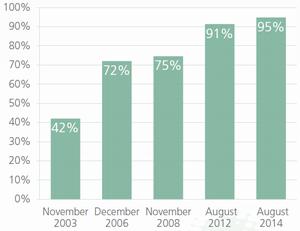
Source: UNODC elaboration on national data.
Looking in more detail at the legislative coverage, the Africa and Middle East region appears to be the part of the world that more than others needs to fill the legislative gap. Eight countries in this region lack a specific trafficking in persons offence. In addition, when considering countries with offences that criminalize only some aspects of trafficking, ten are in this region. On the other hand, it is also very important to consider the population size of countries without adequate legislation in place. When this is taken into consideration, regions other than Africa also emerge as problematic.
Large and densely populated countries in Asia and South America still have partial legislation. As a result, in these countries, there are persons living in trafficking situations constituting an offence according to the international standards, but who may not be considered as trafficking victims by the national authorities as these are using legal definitions not in line with the UN Trafficking in Persons Protocol.
FIG. 27: Criminalization of trafficking in persons with a specific offence, number and share of countries, 2003-2014
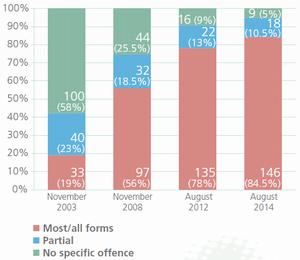
Source: UNODC elaboration on national data.
Combining the population size of the country with the status - lack or partiality - of the legislation shows that about one third of the world's population - some 2 billion people - live in a situation where trafficking is not criminalized as required by the UN Trafficking in Persons Protocol. This situation combined with a very low number of convictions makes trafficking in persons a crime of vast impunity.
Legislation which is not in compliance with the UN Trafficking in Persons Protocol may also leave vast segments of the world's population without the protection and support which victims of human trafficking have the right to obtain. There is also the risk that the traffickers who are exploiting these victims may face light or no criminal charges even when they are detected by law enforcement authorities. In addition, cooperation with national authorities of other countries is often very difficult, as country-level legislation may be incompatible.
Criminal justice response: impunity is rife
The data on investigations, prosecutions and convictions collected for the 2010-2012 period shows that the number of convictions for the crime of trafficking in persons remains very low.
About 15 per cent of the 128 countries covered by the data collection for this Report did not record a single conviction during the reporting period. Another large share of the countries covered, about one fourth, recorded a limited number of convictions, between 1 and 10, in at least one of the years between 2010 and 2012.
Confiscated assets and compensation of human trafficking victims It is generally believed that confiscating the proceeds of crime is both an appropriate punishment and an effective prevention tool. Confiscation is a deterrent for criminals who try to maximize their profits, and it also prevents illicitly acquired assets from being reinvested into the legitimate economy. Confiscation can also serve as a mechanism to disrupt criminal activities, help create an image that crime does not pay and increase public confidence in the criminal justice system.I In addition, confiscated assets can be used to compensate the damage suffered by trafficking victims.
Many countries face significant challenges related to the confiscation of assets in trafficking in persons cases.II Traffickers do their best to hide the illicit profits or place the detected assets beyond the reach of the criminal justice system. Also, the lack of funding often undermines the effectiveness of financial investigation and confiscation efforts. Given these challenges, are there any successful confiscations in trafficking in persons cases, and are these funds substantial enough to be used as compensation for victims of trafficking?
Very little information exists on funds that have been confiscated in relation to trafficking in persons convictions. The data that UNODC has received from some 10 Member States in Europe, Asia and the Pacific, and Central and South America indicates that some countries have been successful in confiscating assets related to trafficking in persons cases between 2010 and 2013. However, the yearly amounts vary greatly from a few thousands to 6 million US dollars. When the confiscated funds are compared to the number of detected victims the funds remain below 9,000 dollars per victim; in most cases below 2,000 dollars per victim.
Both the United Nations Convention against Transnational Organized CrimeIII and the Trafficking in Persons ProtocolIV make specific references to compensation of trafficking victims and the possibility of using confiscated proceeds for the purpose of compensation. Many countries have laws that enable victims of crime to claim compensation for the damages they have suffered.V Despite this legal framework, compensation remains one of the weakest rights of trafficked people.VI Although confiscated assets seem to provide a logical and appropriate source for such compensation, very few countries seem to have sufficient resources to implement the idea. Low numbers of convictions combined with limited use of financial investigations hinder efficient confiscation of assets in human trafficking cases. In order to have efficient and functional compensation schemes based on confiscated assets, countries need to improve their criminal justice responses, particularly by focusing more on financial investigations.
I See, for example, UNODC, Digest of Organized Crime Cases, 2012; RAND Europe, Study for an impact assessment on a proposal for a new legal framework on the confiscation and recovery of criminal assets, report prepared for the European Commission Directorate General Home Affairs, 2012.
II COMP.ACT - European Action for Compensation for Trafficked Persons, Toolkit on Compensation for Trafficked Persons: Findings and Results of the European Action for Compensation for Trafficked Persons, 2012 (www.compactproject.org).
III Articles 14 and 25 (2).
IV Article 6 (6).
V See, for example, Organization for Security and Co-operation in Europe (OSCE), Office for Democratic Institutions and Human Rights, Compensation for Trafficked and Exploited Persons in the OSCE Region, 2008; European Union, Europa -Summaries of EU Legislation, 'The rights of crime victims', 2014, available at: http://europa.eu/legislation_summaries/justice_freedom_security/judicial_cooperation_in_criminal_ matters/l33091_en.htm; Buchanan, C. (editor), Gun Violence, Disability and Recovery, Surviving Gun Violence Project, Sydney, 2014, pp. 37-40.
VI COMP.ACT - European Action for Compensation for Trafficked Persons, Toolkit on Compensation for Trafficked Persons: Guidance on representing trafficked persons in compensation claims, 2012 (www.compactproject.org).
About 40 per cent of the countries covered reported more than 10 convictions, out of which, some 16 per cent had more than 50 convictions in at least one of the years here considered.
The number of convictions and their distribution around the world remained stable compared to the 2007-2010 period. During that period, the number of countries that reported no convictions was about 16 per cent of the total sample, whereas 23 per cent of the countries reported less than ten convictions in one year.
Data limitations prevent a comprehensive comparison between the number of convictions and the number of detected victims. Among the countries that reported on both indicators, most of the countries with few or no convictions also identified or assisted a very limited number of victims. About one third of the countries with few or no recorded convictions, however, detected a significant number of victims. While this suggests that local institutions are responding to the trafficking occurring in their countries by identifying and possibly assisting victims, this does raise the question of why this response does not turn into a final sentence for the traffickers. For some of the countries that record few convictions and a significant number of victims, the use of other offences to convict the traffickers could explain why there is no correlation between the detection of victims and a proper criminal justice response. In other cases, it appears that the identification of a victim does not lead to the prosecution of a trafficker.
Overall, the global picture of the criminal justice response shows few signs of change in recent years. An assessment of how many countries reported increases or decreases in the absolute number of convictions per year during the period 2010-2012 confirms this. The vast majority of the countries reported a relatively stable number of convictions over the 2010-2012 period, while just 13 per cent saw a noticeable increase. However, another 10 per cent of countries recorded decreasing trends over the same period. This means that from a global, aggregated perspective, the situation remained unchanged. Moreover, the share of countries reporting stable conviction trends has not changed significantly since 2003. Between 2003 and 2007, the share of countries with stable or unclear trends was 71 per cent, |44| between 2007 and 2010 it was 60 per cent |45| but between 2010 and 2012, the share was 77 per cent. Similarly, the share of countries with increasing number of convictions decreased from 21 to 13 per cent.
The data above shows that the number of countries that successfully manage to punish at least some of the traffickers that operate in their territories is very limited. It also shows that the situation has not changed in the short to medium term.
As more countries introduced adequate legislation over the last ten years, a gradual increase of convictions worldwide was expected in those countries where trafficking in persons was known to be a problem. Moreover, over the last few years, there has been a perception that proper criminal justice responses would lead to a rising number of convictions some years after the entry into force of the UN Trafficking in Persons Protocol. This has not happened, or perhaps only to a very limited extent. While more countries in the world now have solid legislation in place, the number of convictions is stable at a very low level more or less everywhere.
FIG. 28: Number of convictions recorded per year, share of countries, 2010-2012
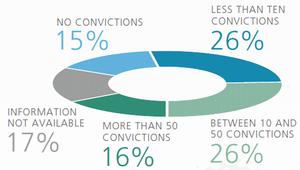
Source: UNODC elaboration on national data.
While it is true that some countries reported large numbers of convictions per year, these were often very populous countries. Their population size alone could explain the large absolute numbers of convictions. When the ratio of convictions per population is considered, Europe and Central Asia reports more convictions per 100,000 population (around 0.3). South Asia, East Asia and the Pacific reports a rate above 0.1, while the Americas and Africa and the Middle East register rates well below 0.1. Globally, the number of convictions per 100,000 population remained basically unchanged in comparison to the 20072010 period (0.1 per 100,000 population).
The wide regional differences obscure different levels of the overall criminal justice response at the national level and at different stages of the criminal justice process.
From investigation to conviction; a brief analysis of the criminal justice response
Where does the criminal justice response start and how does it develop? There are considerable procedural differences between countries. However, it is reasonable to argue that in most legal traditions, the processing of cases through the criminal justice system proceeds according to a similar flow. One may consider three main steps within the process that will ultimately lead to either a conviction or an acquittal. Step one is the formal act of initiating a criminal procedure. This is normally done when the crime is reported and recorded by the authorities. The investigation of the case could lead to the identification and arrest of crime suspects when the crime is often regarded as cleared. The second step starts when the case is turned over to the prosecution service and the suspects are formally charged, on the basis of the evidence collected during the investigation phase. The third step is the trial and its outcome, where the suspect is either found guilty or acquitted. Not all suspects end up being convicted; some may have been wrongly accused, or the evidence may not have been strong enough for a conviction. Moreover, it can be assumed that not all traffickers are identified by the police forces.
FIG. 29: Trends in the number of recorded convictions between 2010 and 2012, share of countries

Source: UNODC elaboration on national data.
It is very challenging to assess the risk of arrest for a trafficker as the number of active traffickers in a certain area is difficult to estimate. However, it is possible to estimate the risks of facing a first-instance conviction for a potential trafficker who has been identified by the police. At the global level, an average of some 24 per cent of those persons who are suspected or investigated by the police for conducting human trafficking activities are convicted (in the first instance). In detail, it appears that about 45 per cent of those suspected by the police are prosecuted. Of the persons prosecuted, 55 per cent are convicted.
FIG. 30: Probability of first-instance conviction for persons investigated for trafficking in persons
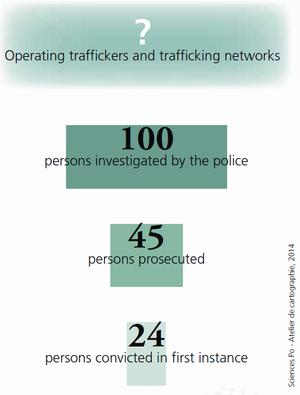
Source: UNODC elaboration on national data.
From the analysis above, it appears that less than one in four suspects face conviction. This reflects the relatively low conviction ratio, which measures the efficiency of criminal justice systems to deal with trafficking in person cases. This, in turn, might be a result of the limited capacity of the police, prosecution and judges to respond to human trafficking crimes. However, considering global and regional averages always risks obscuring different performances. In Western and Central Europe, about 30 persons among those suspected and 50 of those prosecuted are convicted in the first instance. These values are high in comparison to the other regions of the world, which explains the higher number of convictions per 100,000 population discussed above. South Asia, East Asia and the Pacific, as well as the Americas present lower ratios of persons suspected per conviction compared to Europe. However, also within the regions, significant differences can be found at the country-level. In these regions, it is also possible to identify countries where a larger number of those suspected or prosecuted for trafficking in persons proceed to receive convictions.
Do confraternities control the trafficking of Nigerian victims in Europe?I Trafficking of young women from Nigeria to Europe for the purpose of sexual exploitation is one of the most persistent trafficking flows. During the 2007-2012 period, Nigerian victims constantly accounted for more than 10 per cent of the total number of detected victims in Western and Central Europe, making this the most prominent transregional flow in this subregion. Present in different European countries since the late 1990s,II one of the reasons of its endurance may be the structured organization of the trafficking rings.
Typically, during the recruitment phase, the victims are convinced to migrate by means of deception or by peer pressure. In order to finance their migration from Africa to Europe, the women sign a 'contract' with a member of the organization that sponsors the trip. A local 'priest' blesses the contract with a ritual called juju.III The trafficking route follows the main smuggling migration paths by land, sea or air. Victims trafficked to Spain, for instance, may fly to the main airports of the country or of neighbouring countries. In the case of the land route, they will travel through the Sahel, the Sahara to North Africa and cross the border into Ceuta or Melilla in Spain. Similarly, on the route to Italy, they will attempt the sea passage from North Africa to Lampedusa or Sicily.V
Once at destination, the victims are already under the control of the criminal organizations, and sexually exploited by being forced into prostitution in order to pay back the debt contracted with the sponsor. The belief in the power of the juju ritual as well as threats to family members back home normally secure the loyalty of the victims. In Europe, the victims are controlled by madams; older Nigerian women who manage the exploitation phase. The Spanish authorities reported one mean of control used by the madams is guarding the victims' children while the former are in the streets.II
The victims' debt could amount to some 40,000-70,000 euros that would cover just the travel and the protection. The debt will raise for additional expenses. Investigators estimate just 10,000 euros is spent by the organization to transfer the victim into Europe. Once the debt is paid back, the victims are in theory free.II However, some of them may feel that they have few alternatives to continuing prostitution or to becoming madams themselves. While being exploited, some victims may decide to cooperate with the madams in order to have their debt reduced. In that case, they may move up the hierarchy to become controllers. Some victims can also become trafficker so to emancipate from their exploiters by exploiting other girls. Victims in full exploitative situation may still accept such status, as they believe that one day, this system will work in their favour, and they will run their own trafficking ring. In this way, victims are also legal accomplices in the trafficking crime, thus they won't report the traffickers to the authorities.IV
In March 2014, the Italian authorities concluded an investigation named 'CULTS'. As a result of the investigation 34 persons were arrested. These were members of two groups, called the Eiye and Aye confraternities, operative in some parts of Italy since at least 2008. The investigation brought to light a level of organization, violence and intimidation similar to other, better known mafias. The presence of these groups have been detected in some parts of Spain since at least the year 2007.V
In the area of Rome (Italy), the Eiye and the Aye have been fighting for over six years for control of the territories and streets where the victims were sexually exploited. The investigators report that these groups were directly involved in managing the trafficking of young women from the rural areas of Benin City to Italy via Lome' (Togo), and that they had connections in other countries in Europe and in different parts of Italy.V
The Eiye and the Aye confraternities are two of about a dozen criminal groups that started as university campus confraternities in Nigeria. The violent conflicts between these confraternities since the late 1970s is well documented, and there have been hundreds of deaths over the last few decadesVI. Their presence in Europe is more recent, however.
Investigators describe these groups to function through a system of cells (called forum) operating locally but connected to other cells established in different countries in West African, in North Africa, in the Middle East and in Western Europe. The local confraternity cells are involved in different criminal activities wherever they operate. This includes trafficking in persons for the purpose of sexual exploitation, drug trafficking, counterfeiting, documents falsification and money-laundering. They maintain a rigid hierarchical structure headed by a directorate and each forum is independent. The members have a specific functional and hierarchical role; they are connected by familiar or other relational ties. They have defined rules, initiation rituals and hundreds of members operating in Africa and on or in other continents. They use a combination of money collectors, cash mules and corruption to launder and transfer illegal profits from Europe to West Africa.V
As far as these confraternities' involvement in the human trafficking activity is concerned, it appears that the role may change according to the different organizational capabilities of the local forum. In some cases the local forum does not directly engage in the recruitment, transportation and exploitation of victims, but rather 'taxed' and supervised the madam-driven networks that operate independently but within the territory under the confraternity's control. In some other cases, the confraternities are directly managing the recruitment, transfer and exploitation of the victims. They also applied a 'taxation' to free prostitutes who want to operate in the areas under their control.V
Whether or not they do operate the human trafficking directly, the confraternities may facilitate it when they have some leverage to exert. For instance, investigative evidence shows that the confraternities are able to bribe officers in some European airports to facilitate the transit of victims into the European Union free movement area. These groups access institutions in Africa and Europe in order to secure travel documents and impunity. They use systematic corruption and violence to protect and expand their profits from the trafficking.V
On the basis of the evidence collected by the investigators, it is clear that the confraternities play an important role in interfacing with other criminal organizations that operate in the same territory, either peacefully or violently. For instance, in Italy, the members of the Eiye arrested were in business with a group from the Balkans for the distribution of marijuana in the area under confraternity control.V
The Spanish investigators define the trafficking in persons originating from Nigeria as having a serious incidence in Spain (in 2013, 13 per cent of the victims detected and 8 per cent of the suspects arrested in Spain were Nigerian citizens). Some investigators suspect most of the Nigerian groups operating this trafficking operate under the control of the confraternities.V
The endurance of this trafficking flow in almost all Western European countries indicate this maybe the case also in other countries of the continent, although further investigative work would be needed to verify this.
I The primary information for this text box was collected from law enforcement officers specialized on trafficking in persons and organized crime in Italy and Spain. The information concerning Spain was gathered from intelligence reports received from the national authorities of the Centro de Inteligencia Contra el Crimen Organizado (CICO), the Fuerzas y Cuerpos de Seguridad del Estado (Guardia Civil y el Cuerpo Nacional de Policia), and from the Mossos d'Esquadra for what concerns specifically the Autonomous Community of Catalonia in Spain. In Italy, the information was extrapolated from investigative files provided by the Procura Distrettuale Anti Mafia on the operation CULTS, completed in March 2014.
II Primary information collected for this study as indicated in note I. See also Carling, J., Migration, Human Smuggling and Trafficking from Nigeria to Europe, International Organization for Migration (IOM), 2005; Carchedi, F. and Orfano, I., La Tratta di Persone in Italia; Evoluzione del Fenomeno ed Ambiti di Sfruttamento, Osservatorio Tratta, FrancoAngeli, Milano, 2007; UNICRI, Trafficking of Nigerian Girls to Italy - the data, the stories, the social services, 2010.
III Juju is a traditional religious belief of the Yoruba people of Southwest Nigeria on the spirit world affecting the everyday life and it is predominantly practiced is in the Edo state and the River Niger Delta region. Juju was originally created by the early Europeans and it has its origins in the French word joujou, meaning toy or plaything. Juju refers to a small object that is believed to contain energy that brings luck and protection. The early Europeans mistakenly understood these objects to be the focus of worship and named the religious belief as juju. (Anti-trafficking Consultants: http://www.antitrafficking-consultants.co.uk/tactics/)
IV See Lo Iacono, E., 'Victims, Sex Workers and Perpetrators: Grey Areas in the Trafficking of Nigerian Women', Trends in Organized Crime, 2014.
V Primary information collected for this study as indicated in footnote I.
VI Research Directorate, Immigration and Refugee Board, Nigeria: The Black Axe Confraternity, also known as the Neo-Black Movement of Africa, 2005 (Response to Information Request, available at: http://www.irb-cisr.gc.ca/Eng/ResRec/RirRdi/Pages/index.aspx?doc=433931).
CHAPTER II
REGIONAL OVERVIEWSFollowing the global overview, the regional overviews will go into more detail about the trafficking situation in the four regions considered in this Report. The regions are presented in separate sections which first discuss the profiles of offenders, then victims, then trafficking flows and finally the regional responses to the trafficking crime.
TRAFFICKING IN PERSONS IN EUROPE AND CENTRAL ASIA
- Victims are often adult women.
- Sexual exploitation is prominently detected.
- Traffickers from this region are mainly prosecuted there.
- Diversity of trafficking flows, particularly in Western and Central Europe.
In this Report, Europe and Central Asia is divided into two subregions, namely Western and Central Europe, as well as Eastern Europe and Central Asia. The two subre-gions display some similarities in terms of the patterns and flows of trafficking in persons, summarized above. Other aspects are quite different, particularly in relation to trafficking flows. Since the data from this region is solid, particularly for Western and Central Europe, the two subregions will be presented in separate sections.
Western and Central Europe |46|
- Diversity of trafficking flows.
- Many foreign offenders; mostly from within the subregion.
- Mostly adult women victims.
- Sexual exploitation very prevalent.
- All countries have Protocol-compliant legislation.
Western and Central Europe is a region that is both an origin and a destination for trafficking in persons. Countries in Central Europe and the Balkans are mainly origin areas for cross-border trafficking into the rest of Europe. These countries also detect significant levels of domestic trafficking. The richer countries in Western and Southern Europe are generally destinations for victims trafficked from other regions (Asia, Africa and the Americas) and for European victims trafficked from Central Europe and the Balkans. Most of these countries also report considerable levels of domestic trafficking.
Profile of the offenders
The profiles of traffickers convicted in this subregion broadly reflect the different roles of countries in the trafficking process. Western and Central European countries convict citizens of their own country and foreigners in near equal proportions. As shown in map 7, somewhat more than half of the offenders convicted during the 2010-2012 period were citizens of the country of conviction. About 30 per cent of the traffickers were foreigners from countries within the same subregion. Compared to the global average, countries in Western and Central Europe convict fewer own citizens (even though they do make up a majority of offenders) but more foreigners from within the subregion.
Considering origins from outside Western and Central Europe, the largest share is made up of traffickers from Africa and the Middle East. This group accounts for some 10 per cent of the total number of people convicted. Most of these offenders are citizens of countries in West and North Africa. However, the relevance of West African traffickers (some 6 per cent of the convicted offenders) is limited in comparison to the large share of victims from this region that are detected in Western and Central Europe.
Other significant groups of foreign traffickers from outside the subregion are Asians and citizens of countries in the Americas. These groups each account for some 5 per cent of the offenders in this region. Offenders from Eastern Europe and Central Asia comprise a small, but significant share, with 2 per cent of the total. The citizenship profiles of the foreign offenders broadly mirror the profiles of the detected foreign trafficking victims, at least by major regional aggregations. A statistical analysis presented in the section Traffickers, organized crime and the business of exploitation indicated that there is a quantitative relation between the citizenships of offenders and victims detected in Western and Central Europe, when foreigners are considered in both categories. The same result was found in other destinations of trafficking in persons and confirmed by a qualitative analysis of the court cases submitted by Member States. |47|
MAP 7: Citizenships of convicted traffickers in Western and Central Europe, by subregion, shares of the total, 2010-2012 (or more recent)
Source: UNODC.
The global findings show that areas that are more typical origins for cross-border trafficking in persons tend to have vastly different offender profiles than areas that are more typical destinations. As Western and Central Europe is a subregion that encompasses countries of origin as well as destination of cross-border trafficking, this is true also there. Countries in the Balkans and Central Europe |48| are mainly origin areas (with most victims trafficked to Western Europe) and thus convict largely local citizens. More than 9 in 10 convicted traffickers in these areas are own citizens. Countries in Western and Southern Europe -mainly countries of destination - convict large shares of foreigners, approximately 60 per cent. Almost all - about 97 per cent - of the foreigners who were convicted of trafficking in persons in Western and Central Europe were detected in the more typical destination countries of cross-border trafficking.
FIG. 31: Distribution of national and foreign offenders among countries of origin and destination of cross-border trafficking in Western and Central Europe, 2010-2012
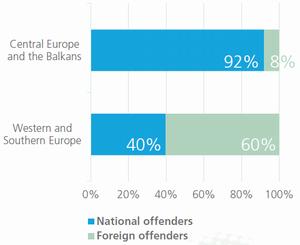
Source: UNODC elaboration on national data.
FIG. 32: Prosecutions for trafficking in persons in Western and Central Europe, by gender, 2010-2012 (or more recent)
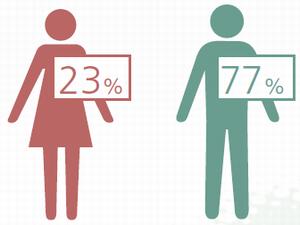
Source: UNODC elaboration on national data.
FIG. 33: Convictions for trafficking in persons in Western and Central Europe, by gender, 2010-2012 (or more recent)
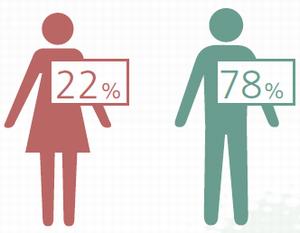
Source: UNODC elaboration on national data.
In terms of the gender of the offenders, countries in Western and Central Europe prosecute and convict somewhat fewer women than the global average. Some 23 per cent of those prosecuted and/or convicted of trafficking in persons in this subregion are women, compared to some 28 per cent at the global level.
Countries within the subregion report significant differences in the shares of women who are prosecuted and convicted. Some countries, for example in the Balkans, have very low shares of convictions of women. In other countries, including in the Baltic area, women comprise nearly one third of the convicted trafficking offenders.
Profile of the victims
On average, countries in Western and Central Europe detect more adult victims and more women victims than other (sub)regions. A majority of the detected victims of trafficking in persons in Western and Central Europe -some 63 per cent - are adult women, whereas the second largest group is adult men, who account for 19 per cent of the total number or victims. Adult victims thus comprise more than 80 per cent of all detected victims in this subregion.
The detection of child trafficking in Western and Central Europe is not as common as in other regions. Children account for almost 20 per cent of the detected victims, whereas globally, this group makes up nearly one third of victims. Girls are much more frequently detected than boys. Out of every five children trafficked in Western and Central Europe, four are girls and one is a boy.
FIG. 34: Gender and age profiles of victims detected in Western and Central Europe, 2010-2012 (or more recent)

Source: UNODC elaboration on national data.
Most of the detected victims in this subregion – approximately 65 per cent - were subjected to sexual exploitation. This seems to be connected to the high share of females among the total number of detected victims since trafficking for sexual exploitation largely affects women. Trafficking for sexual exploitation does not only affect females, however. Some 4 per cent of the victims of this type of trafficking were males in Western and Central Europe during the 2010 – 2012 period.
FIG. 35: Forms of exploitation detected in Western and Central Europe, 2010-2012 (or more recent)
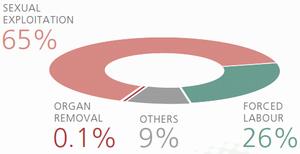
Source: UNODC elaboration on national data.
FIG. 36: Gender breakdown of victims trafficked for forced labour in Western and Central Europe, 2010-2012 (or more recent)
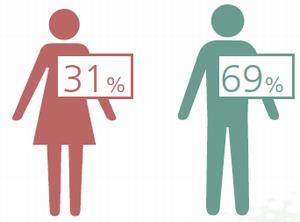
Source: UNODC elaboration on national data.
The large share of victims trafficked for sexual exploitation implies that forced labour is less commonly detected in this subregion. 25 per cent of the victims detected in Western and Central Europe were exploited in forced labour. About 30 per cent of these victims were females, while about 70 per cent were males.
In Western and Central Europe, victims exploited in 'other' forms of trafficking are relatively frequently detected. Some 9 per cent of victims were trafficked for purposes other than sexual exploitation or forced labour. For instance, about 1.5 per cent of the detected victims were trafficked for begging, while more than 1 per cent were trafficked for the purpose of committing (often petty) crime. Other types of exploitation in this category include forced marriages, welfare fraud, children exploited for the production of pornographic material, as well as mixed sexual and labour exploitation.
As far as the gender distribution for trafficking for 'other' purposes is concerned, for victims detected in Western and Central Europe between 2010 and 2012, female victims account for some 72 per cent of the victims of this type of trafficking.
Trafficking flows
The most striking feature of trafficking in persons in Western and Central Europe is the diversity of trafficking flows associated with this subregion. As mentioned before, it is a significant origin and destination area simultaneously. From an origin point of view, victims from this subregion are largely trafficked within the subregion, mainly from Central Europe and the Balkans towards the other countries, and in terms of domestic trafficking.
As a destination area, Western and Central European countries detected victims of more than 130 different citizenships, displaying a vast variety of trafficking flows directed to this part of the world. The victims detected here between 2010 and 2012 were mainly from within the subregion, but also from a broad range of other countries. In other words, while the subregional nature of trafficking in persons is the key feature, at the same time, Western and Central Europe is also a significant destination area for victims from elsewhere.
Cross-border trafficking originating from within the sub-region accounts for the largest share of detected victims, nearly 40 per cent. Victims from approximately 40 Western and Central European countries have been detected in the subregion. The vast majority of these victims come from countries in the Balkans. Victims from the Balkan area have been identified in significant numbers in all parts of Western and Central Europe.
Domestic trafficking accounts for about one fourth of the total number of victims detected in Western and Central Europe. Added up, the shares of subregional cross-border trafficking and domestic trafficking show that more than six in 10 victims detected in Western and Central Europe are citizens of countries within the subregion.
However, the trafficking flows are different when focusing on different areas within the subregion. When the analysis considers the more affluent countries in Western and Southern Europe, domestic trafficking accounts for 16 per cent of the total number of detected victims, while for countries in Central Europe and the Balkans, it accounts for about 80 per cent of the detected victims.
MAP 8: Origins of victims trafficked to Western and Central Europe, by subregion, share of the total number of victims detected there, 2010-2012
Source: UNODC.
MAP 9: Origins of victims trafficked to Western and Southern Europe, share of the total number of victims detected there, 2010-2012 (or more recent)
Source: UNODC.
MAP 10: Origins of victims trafficked to Central Europe and the Balkans, share of the total number of victims detected there, 2010-2012 (or more recent)
Source: UNODC.
MAP 11: Destinations of trafficking victims from Central Europe and the Balkans, as a proportion of the total number of victims detected at specific destinations, 2010-2012
Source: UNODC.
As for cross-border trafficking from within the subregion, countries in Central Europe and the Balkans mainly receive trafficking victims from neighbouring countries of the same area, as well as victims from proximate countries in Eastern Europe. The more affluent countries in Western and Southern Europe report significant inflows from the Balkans (27 per cent) and from Central Europe (13 per cent).
Trafficking from the Balkans into the rest of the subregion remains very significant. It is, however, limited to Europe as detections of victims from the Balkans outside Europe are rare. Trafficking victims originating from Central Europe have been increasingly detected in the rest of Europe compared to the period 2007-2010. In addition, and as opposed to the victims from the Balkans, citizens of countries in this area have been detected outside Europe, particularly in North and Central America and the Caribbean. It is thus a trafficking flow that should be monitored in the future.
Moreover, more than 2 per cent of the detected victims in Western and Central Europe were trafficked from one of the Baltic countries. This is a small share, but considering the limited population of these countries, it is nonetheless significant.
Trafficking from countries in the other European subregion, Eastern Europe and Central Asia, into Western and Central Europe, accounts for about 4 per cent of the total number of detected victims, which is a very similar value to what was reported for the 2007-2010 period in the Global Report on Trafficking in Persons 2012 (almost 5 per cent).
FIG. 37: Evolution of the origins of trafficking into Western and Central Europe, 2007/2010-2010/2012
Source: UNODC elaboration on national data.
Although subregional trafficking is more prominently detected, the share of victims who are trafficked transre-gionally to Western and Central Europe is almost 40 per cent. This share reaches peaks of 50 per cent in the countries of Western and Southern Europe, while such trafficking is marginal for the countries in Central Europe and the Balkans. The dispersion of these victims' origin countries is remarkable. Victims with some 80 non-European citizenships were detected across Western and Central Europe between 2010 and 2012. This subregion is clearly one of the main destinations for transregional trafficking. Other wealthy areas also receive a lot of inbound cross-border trafficking, but that tends to come from countries that are relatively close in geographical terms. Western and Central Europe is the only region to detect victims from every other region in significant numbers.
Looking specifically at the origins of transregional trafficking flows, the trafficking of Africans, particularly West Africans, appears to be the most significant. Detections of West Africans are second only to that of people from the Balkans in terms of shares of the total number of victims who are trafficked cross-border. West African victims have been detected in 20 countries across most of Western and Central Europe. The relevance and endurance of this trafficking flow across many parts of Western and Central Europe might indicate the presence of a well-organized structure behind the flow.
Trafficking from other parts of Sub-Saharan Africa is also detected. Moreover, victims from North African countries - especially from the Maghreb - are broadly dispersed. These victims are detected in limited numbers but in different countries.
The detection of victims from the Americas used to be largely limited to Spain and Portugal. This has changed, and nowadays, victims from the Americas – primarily South America, and to a lesser extent, Central America and the Caribbean - have been detected in other countries of this subregion. During the 2010-2012 period, South American victims accounted for 6 per cent of the total number of victims detected in Western and Central Europe.
Victims from the Caribbean accounted for approximately 1.5 per cent of the total number of detected victims in some 9 countries in Western and Central Europe. This is quite a remarkable share for relatively small and distant countries.
Asian victims are also detected in significant numbers in Western and Central Europe. This group accounts for about 6 per cent of the total number of detected victims. East and South-East Asian victims have been detected in many countries. Additionally, South Asian victims have been detected in many countries in Western and Central Europe, but in limited numbers.
Response to trafficking in persons
In terms of legislation, all the countries in Western and Central Europe considered in this Report have national legislation that is in line with the UN Trafficking in Persons Protocol today. The historical evolution of the legislation in this part of the world was, to a considerable extent, affected by the entry into force of the Protocol in December 2003. More than half of the countries amended their criminal code after this date to introduce a specific offence on trafficking in persons that was in line with the international standards.
FIG. 38: Historical evolution of the legislation in Western and Central Europe, 2003-2012

Source: UNODC elaboration on national data.
FIG. 39: Number of Western and Central European countries according to the number of convictions per year reported, 2010-2012
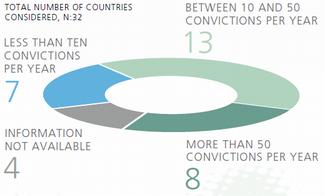
Source: UNODC elaboration on national data.
While several of the countries had specific legislation before December 2003, the offences were often introduced either in the year 2002 or earlier in 2003. So for many of these countries as well, the legislation was amended as a result of the political push generated by the Trafficking in Persons Protocol that was adopted by the Member States in the year 2000.
A further geographical analysis shows that the countries in Central Europe and the Balkans were the quickest in setting up their legislative counter-trafficking framework. Among the 18 countries with proper legislation in place in 2003, 6 were in Western Europe, while 12 were in Central Europe and the Balkans. The gap was quickly closed, however, as after just five years, most of the countries had adopted proper legislation to combat trafficking in persons.
In Western and Central Europe, eight countries recorded more than 50 convictions in at least one year during the 2010-2012 period.
On average, 30 per cent of trafficking in persons suspects in Western and Central Europe received a conviction in the first instance. About half of those prosecuted got a first-instance conviction.
Eastern Europe and Central Asia
- Most of the detected trafficking is intraregional; few victims trafficked from other regions.
- Many female traffickers and victims.
- Mainly sexual exploitation, but more forced labour than in Western and Central Europe.
- All countries have Protocol-compliant legislation.
One of the key characteristics of trafficking in persons in Eastern Europe and Central Asia is the strong involvement of women, both as traffickers and victims.
Profile of the offenders
Considering both prosecutions and convictions, almost half of the traffickers in Eastern Europe and Central Asia are women. While women are more involved in trafficking in persons than most other crimes, a female offending rate of some 50 per cent is exceptional as the global average for trafficking in persons is around 30 per cent.
The vast majority of the traffickers convicted in this sub-region – more than 90 per cent - are local citizens convicted in their own countries. About 8 per cent are foreigners from countries within Eastern Europe and Central Asia. This is an expected citizenship profile breakdown for a subregion which mainly experiences intraregional and domestic trafficking in persons and which is mainly an origin area for trafficking victims.
FIG. 40: Prosecutions for trafficking in persons in Eastern Europe and Central Asia, by gender, 2010-2012 (or more recent)
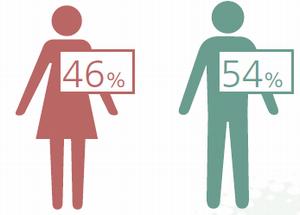
Source: UNODC elaboration on national data.
FIG. 41: Convictions for trafficking in persons in Eastern Europe and Central Asia, by gender, 2010-2012 (or more recent)
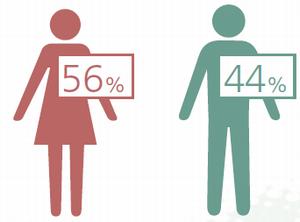
Source: UNODC elaboration on national data.
Some 3 per cent of the convicted traffickers in Eastern Europe and Central Asia come from other (sub)regions; most of them from Western and Central Europe, but also some from the Middle East. Both are areas of destination for victims who are citizens of countries in Eastern Europe and Central Asia. For example, in the court cases submitted to UNODC by Member States, a case from Belarus saw a man from a country in Western and Central Europe convicted in Belarus for his involvement in trafficking local women via his own country to another Western European destination for sexual exploitation. He was living in Belarus and targeted poor women looking for work opportunities abroad. Through promises of well-paid work, he deceived the victims to travel abroad. Their first stop was the offender's home country where the women were met by his accomplices. While this man was the only offender sentenced in the case (he received a prison sentence of seven years), the case brief made it clear that several others were also involved.
Profile of the victims
While the prominent detections of women victims in the entire region has already been mentioned, in Eastern Europe and Central Asia it is particularly high, at 77 per cent. This is the highest share of women victims of any (sub)region.
Some 15 per cent of the detected victims are men, which brings the share of adult trafficking victims in this subregion well above 90 per cent. This is a very large share in a global perspective. Detected child trafficking is marginal compared to adult trafficking in Eastern Europe and Central Asia, as only about 8 per cent of the detected victims are children. As in Western and Central Europe, child trafficking mainly concerns girls.
FIG. 42: Citizenships of convicted traffickers in Eastern Europe and Central Asia (by region/subregion), 2010-2012 (or more recent)

Source: UNODC elaboration on national data.
FIG. 43: Gender and age profiles of victims detected in Eastern Europe and Central Asia, 2010-2012 (or more recent)
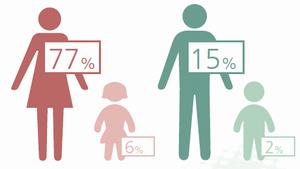
Source: UNODC elaboration on national data.
FIG. 44: Forms of exploitation detected in Eastern Europe and Central Asia, 2010-2012 (or more recent)
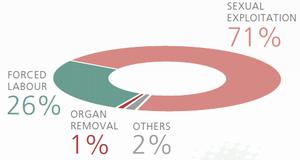
Source: UNODC elaboration on national data.
FIG. 45: Gender breakdown of victims trafficked for forced labour in Eastern Europe and Central Asia, 2010-2012 (or more recent)
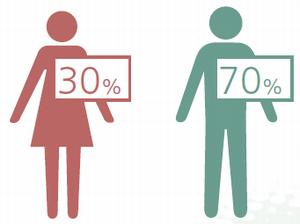
Source: UNODC elaboration on national data.
In terms of the forms of exploitation, sexual exploitation is by far the most commonly detected form, accounting for more than 70 per cent of the victims.
About 26 per cent of the victims detected here are trafficked for forced labour. A relatively large share of forced labour victims detected in Eastern Europe and Central Asia are women; some 30 per cent.
About 50 victims of trafficking in persons for the purpose of organ removal were detected during the period considered in Europe and Central Asia; 38 of them in Eastern Europe and Central Asia. About 80 per cent of these victims were males.
Trafficking flows
Most of the victims who are detected in countries in Eastern Europe and Central Asia originate from that subregion, regardless of whether they are victims of domestic trafficking or cross-border trafficking within the subre-gion. In other words, there are very few foreigners from outside Eastern Europe and Central Asia trafficked into the subregion for exploitation there.
Moreover, nearly all - 99 per cent - of the victims detected in this subregion are either domestically trafficked or trafficked from neighboring countries within the subregion.
MAP 12: Destinations of trafficking victims from Eastern Europe and Central Asia, as a proportion of the total number of victims detected at destination, 2010-2012
Source: UNODC.
From an origin perspective, victims from Eastern Europe and Central Asia have been detected in or repatriated from a large number of countries, especially in Western and Central Europe. Victims from this subregion have also been significantly detected in the Middle East and in East Asia. While detections of these citizens are decreasing, at least in Western and Central Europe, North America and the Middle East, displacement of these trafficking flows to other regions or intra-regionally cannot be excluded.
Response to trafficking in persons
All countries in Eastern Europe and Central Asia now have legislation in line with the UN Trafficking in Persons Protocol. Similar to Western and Central Europe, the year 2003 marked the moment when a wave of new legislation started to be introduced.
Among these countries, the Central Asian ones needed most time to have legislation fully in line with the international standards of the Trafficking in Persons Protocol.
FIG. 46: Historical evolution of the legislation in Eastern Europe and Central Asia, 2003-2012

Source: UNODC elaboration on national data.
The number of persons convicted per 100,000 population in Europe and Central Asia is high in comparison to the rest of the world, and the average rates in Eastern Europe are somewhat higher than in Western Europe. However, the highest rates of convictions per population in Europe, and in the world, are registered in the Balkans, with a peak of 2 convictions per 100,000 population.
Most of the countries in Eastern Europe and Central Asia reported having between 10 and 50 convictions for trafficking in persons per year. For two countries in this sub-region, however, this information was not available.
TRAFFICKING IN PERSONS IN THE AMERICAS
- Forced labour prominent.
- Many foreign traffickers convicted in origin countries.
- Large share of women traffickers.
The region of the Americas encompasses the subregions of North and Central America and the Caribbean, and South America. While the two subregions are different in some respects, particularly regarding trafficking flows, they display many similarities in terms of the patterns. For this reason, they will be considered together in this section, with a subregion-specific brief analysis of trafficking flows at the end.
Profile of the offenders
With regard to the citizenships of the offenders, as a result of lack of data from key countries, only a partial analysis can be presented. As in other parts of the world, most of the offenders in the Americas are people convicted of trafficking in persons in their own country of citizenship (about 80 per cent of the total number of convicted offenders). About 17 per cent of the offenders are citizens of other countries in the region, whereas some 3 per cent are traffickers from countries in other regions. Some of the traffickers in this group are citizens of typical destination countries for South American victims.
Keeping in mind the global finding that most foreign traffickers are convicted in destination countries, the Americas region is somewhat anomalous. The participation of foreign traffickers in countries of origin in this region seems to be higher than in most other parts of the world. Some 13 per cent of the foreign traffickers were convicted in typical origin countries of cross-border trafficking, and this may be a low figure as data from some key countries is missing.
FIG. 47: Citizenships of offenders convicted in the Americas (by (sub)region), 2010-2012 (or more recent)

Source: UNODC elaboration on national data.
FIG. 48: Convictions of foreign offenders (relative to the convicting country) by countries of origin and destination of cross-border trafficking in the Americas, 2010-2012
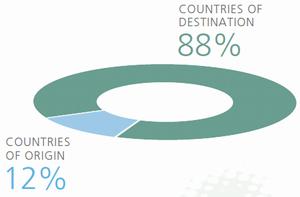
Source: UNODC elaboration on national data.
Traffickers from countries in the Americas are not only convicted there, however. Western European countries have convicted a significant number of citizens of countries in South America and the Caribbean during the reporting period. Citizens of countries in the Americas account for about 4 per cent of the total number of convicted persons in the subregion of Western and Central Europe.
Overall, the share of women among the total number of traffickers in the Americas is also relatively high, ranging around 40 per cent for prosecutions as well as convictions. These shares are similar in both subregions, even if somewhat higher in South America. A closer look reveals that Central American countries record higher shares of female involvement in the trafficking process (which may be related to the profile of the victims detected there), whereas Canada in North America reported a much lower female conviction rate.
FIG. 49: Prosecutions for trafficking in persons in the Americas, by sub-region and gender, 2010-2012 (or more recent)
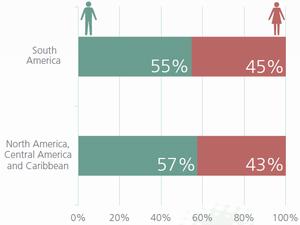
Source: UNODC elaboration on national data.
FIG. 50: Convictions for trafficking in persons in the Americas, by subregion and gender, 2010-2012 (or more recent)

Source: UNODC elaboration on national data.
Profile of the victims
The profiles of the victims detected across the two subre-gions of the Americas are similar. Child trafficking accounts for almost 30 per cent of the total number of detected victims, with adults making up the other 70 per cent. These shares are similar to those found for the 2007-2010 period.
A closer look at the two subregions brings to light some differences in terms of the profiles of detected victims. While in North America and in the South Cone of South America, adult trafficking accounts for a larger share of victims than the regional average, the share of detected child trafficking is relatively high in Central America and in the northern part of South America.
Most of the detected child victims are girls. Out of every three children detected as victims, two are girls and one is a boy. This breakdown applies to the whole region. The females also dominate among the adults. Adult women account for approximately half of all detected victims in the Americas, whereas some 20 per cent are men.
There is a clearly increasing detection rate of children in North and Central America and the Caribbean. In South America, however, the country-level trends are more mixed.
FIG. 51: Age profiles of detected victims in the Americas, by subregion, 2010-2012 (or more recent)
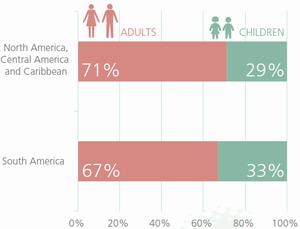
Source: UNODC elaboration on national data.
FIG. 52: Share of children among the total number of detected trafficking victims, selected countries in the Americas, 2007-2012
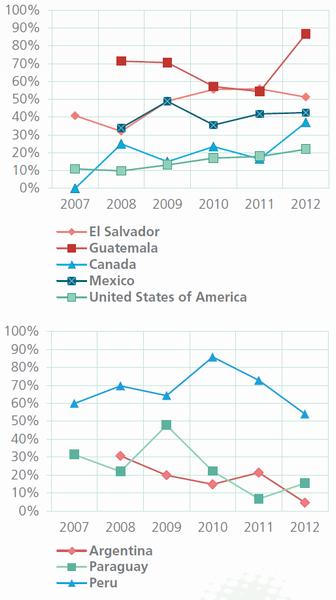
Source: UNODC elaboration on national data.
In the Americas, trafficking for forced labour is prominently detected. In North and Central America and the Caribbean, this form of trafficking accounts for more than half of the detected victims, whereas in South America, the share is above 40 per cent. It is very likely that trafficking for forced labour is underreported to an unknown extent in some South American countries. Some countries have legislation that only covers trafficking for sexual exploitation, and some register situations that may be cases of trafficking for forced labour under offences such as 'slavery' or similar practices.
Assuming that all countries in South America had legislation consistent with the Trafficking in Persons Protocol and used the Protocol framework for defining trafficking in persons in their responses to this crime, it is likely that forced labour would emerge as the main form of trafficking detected in South America.
Two of the cases that involved large numbers of victims among the court cases submitted by Member States were cases of trafficking for forced labour. One was a case from North America (Canada), and the other, from South America (Argentina). The sectors involved were construction and manufacturing, and in both cases, the victims were trafficked from relatively poorer to relatively richer countries by extended family members or family friends. In the Canadian case, it was clearly an organized crime group, as approximately 10 people were convicted. In the Argentine case, there were two convicted offenders – father and son.
The detection of trafficking for sexual exploitation in this region is broadly inverse to the shares of forced labour. In South America, such trafficking accounts for some 55 per cent of the detected victims, whereas in North and Central America and the Caribbean, some 40 per cent. In both subregions, some 5 per cent of victims are subjected to 'other' forms of trafficking, including mixed exploitation (sexual and labour) and trafficking for begging.
FIG. 53: Forms of exploitation detected in the Americas, by subregion, 2010-2012 (or more recent)
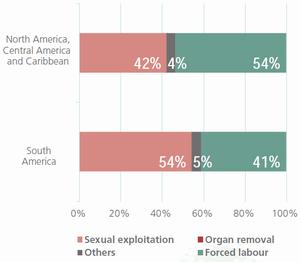
Source: UNODC elaboration on national data.
FIG. 54: Gender breakdown of victims trafficked for forced labour in the Americas, by subregion, 2010-2012
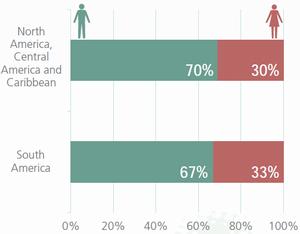
Source: UNODC elaboration on national data.
A closer look at the victims for forced labour shows that the gender profile of these victims in the Americas is very similar to that found in Europe and Central Asia. Some 30 per cent of the victims who were trafficked for forced labour are females, and 70 per cent are males. Less than 5 per cent of the victims who were trafficked for sexual exploitation are males.
Trafficking flows
Turning now to trafficking flows in the subregion of North and Central America and the Caribbean, 58 per cent of the relevant flows are either domestic or subregional. This is consistent with past Reports as well as results from other parts of the world. Looking at detections in some detail, victims from Central America have been trafficked across the borders into neighboring countries in Central America, and victims from the Caribbean have been detected in the Caribbean. Central American and Caribbean victims have also been detected in North America. In addition, domestic trafficking is also commonly detected. Overall, the detections show a clear pattern of trafficking of persons from relatively poorer origin countries towards comparatively richer destinations within the same subregion.
Transregional flows comprise more than 40 per cent of the detected trafficking to North and Central America and the Caribbean. This means that this subregion is a significant destination for such flows. The origins of flows destined for North America are much less diverse than those of European countries, however. The main origin of inbound long-distance trafficking is Asia, and particularly East Asia. More than one in four of the victims detected in North and Central America and the Caribbean are from East Asian countries and these victims were mainly detected in the United States and Canada. Additionally, victims from South Asia were detected in significant numbers in the United States during the reporting period.
MAP 13: Origins of victims trafficked into North and Central America and the Caribbean, shares of the total number of victims detected, 2010-2012 (or more recent)
Source: UNODC.
FIG. 55: Evolution of the origins of trafficking into North and Central America and the Caribbean, 2007/2010-2010/2012
Source: UNODC elaboration on national data.
This subregion also reported an increasing share of victims from Western and Central Europe - mainly Central European countries – and these victims now account for about 5 per cent of the total number of detected victims there. This is larger than the share of detected victims from the neighbouring subregion of South America as these victims comprise some 3 per cent of the total number.
Looking at this subregion as origin of trafficking victims, as mentioned previously, most of the trafficking is intraregional. As a result, most victims from this part of the world are trafficked to a richer country nearby, or to a richer area within the same country.
However, there are also some transregional trafficking flows originating from the subregion, particularly countries in the Caribbean.
Turning now to South America, this is by and large a sub-region of destination for domestic or intraregional trafficking. Almost all the victims detected in South American countries are either citizens of the detecting country or have been trafficked across the border from neighbouring countries. The same broad pattern of trafficking from relatively poorer towards comparatively richer areas can be discerned. For example, Bolivians are trafficked to Argentina, Brazil, Chile and Paraguay; Paraguayans and Peruvians are trafficked to Argentina and Chile; and Colombians are trafficked to Chile and to some Central American countries, to mention some of the flows.
MAP 14: Destinations of trafficking victims originating in North and Central America and the Caribbean, proportion of the total number of detected victims at destinations, 2010-2012 (or more recent)
Source: UNODC.
MAP 15: Origin of victims detected in South America, as a proportion of the total number of victims detected in the subregion, 2010-2012 (or more recent)
Source: UNODC.
In terms of inbound trafficking from outside the subregion, this only accounts for some 6 per cent of the total number of detected victims. This share mainly comprises East Asian victims, as well as a limited number of victims from Central America and the Caribbean.
As an origin area for trafficking in persons out of the sub-region, South American victims have been detected in a variety of countries. The most pertinent flows are those directed towards Western and Central Europe (some 6 per cent of the victims detected there), and North and Central America and the Caribbean (some 3 per cent, mainly detected in Central American and Caribbean countries). A limited number of South American victims have also been detected in East Asia and the Pacific, and in North Africa and the Middle East.
Response to trafficking in persons
In terms of the regional response to trafficking in persons, most of the countries have specific legislation today, although for some of the countries, the legislative coverage is partial. All North and Central American countries have a specific offence in line with the UN Trafficking in Persons Protocol. Among those considered, one country in the Caribbean lacks a specific offence on trafficking in persons, while four countries in South America and the Caribbean criminalize only some aspects of trafficking in persons.
Most of the countries in this part of the world did not include trafficking in persons in their criminal code before the entry into force of the Trafficking in Persons Protocol in 2003. In fact, only three countries had a specific offence in line with international standards at that time, while five had partial legislation. A few years later, the situation improved. In 2008, almost half of the countries in the Western Hemisphere had legislation on trafficking in persons in compliance with the international standards. Nowadays, the situation has further improved as a vast majority of the countries have full-fledged legislation.
The criminal justice response in the Western Hemisphere shows that among the countries considered, only the United States of America and Peru reported more than 50 convictions for trafficking in persons per year. Some countries in Central America and in the Caribbean did not report a single conviction, while the rest of the countries registered below or around 10 convictions per year.
MAP 16: Destinations of trafficking victims originating in South America, proportion of the total number of detected victims at destinations, 2010-2012 (or more recent)
Source: UNODC elaboration on national data.
FIG. 56: Historical evolution of the legislation in the Americas, 2003-2014
Source: UNODC elaboration on national data.
When comparing the number of suspects to the number of convictions, the latter are about 10 per cent of the former. There is a large discrepancy between the number of cases of trafficking that are investigated by the police and the number of persons who are convicted in the first instance. On average, about 40 per cent of the prosecuted persons are convicted in the first instance. The United States reports a share of federal convictions to prosecutions of about 70 per cent, which is the largest reported share in the region.
TRAFFICKING IN PERSONS IN SOUTH ASIA, EAST ASIA AND THE PACIFIC
- Origin area for victims trafficked across the world.
- Many female victims, and many children detected.
- Forced labour is prominently detected.
- Most offenders come from within the region.
One of the key features of this region in terms of trafficking in persons is that it is a significant origin region for victims who are trafficked across much of the world. East Asian victims, in particular, have been widely detected outside East Asia. The broad dispersion of East Asian victims has been evident for several years, and has also been highlighted in previous editions of this Report.
As a destination of trafficking, South Asian countries are mainly affected by domestic trafficking or trafficking from the neighboring countries. Most of the victims detected in this subregion are trafficked within national borders. However, South Asian victims are largely detected in the Middle East and increasingly detected in North and Central America and the Caribbean. They also comprise a significant share of the victims detected in Western and Central Europe.
Profile of the offenders
The broad geographical dispersion of East Asian trafficking victims is reflected in prosecution and conviction statistics. These show that East Asian traffickers have been convicted in 15 countries in several regions. Regions convicting significant numbers of East Asians include (in addition to East Asia) Western and Central Europe, where they account for some 4 per cent of the total number of convicted persons, and Africa and the Middle East, where they account for some 10 per cent, particularly in the Middle East. East Asians have also been convicted in the Americas. Moreover, South Asians are convicted in large numbers in the Middle East.
Looking at the citizenships of those convicted of trafficking in persons in South Asia, East Asia and the Pacific, the vast majority of traffickers come from this region. Almost all are local citizens convicted in their own countries (97 per cent). About 3 per cent of the offenders convicted in this region are foreigners, and almost all of them come from the same subregion. This can be explained by the fact that most of the trafficking bound for this region originates from the same area.
Very few people from Europe and Central Asia, North Africa and the Middle East, or the Americas have been convicted in Asia, in spite of the fact that these areas are significant destinations for Asian victims. This suggests that trafficking flows are either maneuvered in the origin countries, or trafficking networks operating in the destination countries recruit local traffickers to 'collect' victims from their origins.
Regarding the gender profiles of offenders, in East Asia and the Pacific, it seems that women and men are prosecuted in relatively equal proportions, depending somewhat on the country concerned.
The limited information on the profile of the persons convicted does not permit a comprehensive analysis on the gender distribution of the offenders.
FIG. 57: Prosecutions for trafficking in East Asia and the Pacific, by gender, 2010-2012
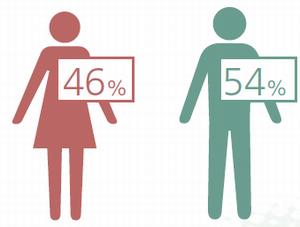
Source: UNODC elaboration on national data.
Similar problems also hinder such an analysis for South Asia. Here, very little information is available on the gender profile of offenders. There is no information from prosecutions or convictions, however, received information indicates that women are involved. A bit more than 40 per cent of the persons investigated for trafficking in persons in India were females. The corresponding share was 26 per cent in Nepal.
Profile of the victims
The vast majority of the victims detected in Asia are females, either adults or underage girls. Trafficking of males accounts for about 17 per cent of the total number of victims detected in this region, which is somewhat lower than the global average. Moreover, trafficking in children is reported relatively frequently here.
Looking at South Asia, the share of child victims detected here is second only to the share recorded in Sub-Saharan Africa. Bangladesh reports a high level of child trafficking, while in Nepal, women remain the most frequently reported victims of trafficking. Unfortunately, the data concerning other countries is incomplete, rendering a rather partial subregional picture.
In East Asia and the Pacific, the profile of the victims varies according to the specific area under consideration, though female victims are most frequently detected. In Australia and Japan, adult women make up the bulk of the detected victims, whereas in countries in the Mekong basin, the share of child victims is relatively high.
FIG. 58: Age profiles of detected victims in South Asia, East Asia and the Pacific, by subregion, 2010-2012

Source: UNODC elaboration on national data.
FIG. 59: Forms of exploitation detected in South Asia, East Asia and the Pacific, by subregion, 2010-2012
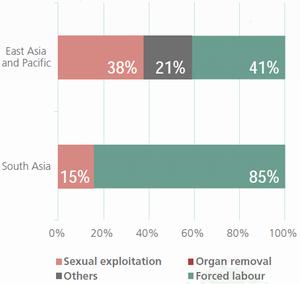
Source: UNODC elaboration on national data.
A significant majority of the detected victims trafficked in South Asia are exploited in labour. Forced labour is the most frequently detected form in East Asia and the Pacific, although the breakdown of forms of exploitation there also reveals large shares of trafficking for sexual exploitation as well as 'mixed' exploitation which may include unknown proportions/combinations of sexual exploitation, forced labour and/or forced marriages.
Very little further information regarding the gender profile of the victims in this region is available. The vast majority (more than 7 in 10) of the victims trafficked for forced labour in East Asia and the Pacific are females. No information is available on this for South Asia.
Two of the case briefs from the court cases submitted by Member States dealt with domestic servitude. Both cases were submitted by Brunei Darussalam, and both involved women from South-East Asia whose original employment as domestic servants turned into trafficking cases. Moreover, both cases involved two defendants, in each case, one man and one woman (a married couple in one of the cases). The victims did not receive their wages, and they were locked up, deprived of food and/or severely physically abused.
Trafficking flows
The main destinations for victims from the subregion of East Asia and the Pacific (outside of the subregion) are North America and the Middle East, and to a lesser extent Western Europe. Victims from East Asia and the Pacific are also being detected in Sub-Saharan Africa and episodically in South America and Eastern Europe. Victims do not originate from one country only, but from many of the countries in South-East Asia.
Victims from South Asia are also trafficked relatively widely outside their subregion, albeit in smaller numbers and to fewer locations than East Asians. Victims from South Asia have been detected in or repatriated from 37 countries in all regions of the world. These victims, originating from nearly all the countries in the subregion, account for some 18 per cent of the total number of detected victims in the Middle East. They also comprise significant shares of the victims detected in North and Central America and the Caribbean (where detections of South Asians appears to be increasing compared to the 2007-2010 period) and Western Europe.
Although the region is a significant origin region for victims of transregional trafficking, as for most other parts of the world, the vast majority of the victims detected within South Asia, East Asia and the Pacific are either domestically trafficked or trafficked within the same sub-region. This is true for both the region's subregions, South Asia, as well as East Asia and the Pacific. All countries in the region are origins and destinations simultaneously, with the exceptions of Australia and Japan, which are destination countries for victims from all over the region.
Countries in South Asia report having detected mainly victims trafficked within the national borders; that is, domestic trafficking. In addition, India also detected victims from other countries in the subregion, particularly Nepal and Bangladesh. Victims trafficked from other areas – for example Eastern Europe - have also been detected in India, but only sporadically.
The situation is similar in East Asia and the Pacific, where most victims are trafficked domestically or from neighbouring countries. Thailand detects a significant number of victims from the greater Mekong area. Victims from the Mekong area and the poorer countries in South-East Asia are often trafficked to the richer countries. Additionally, a small number of victims trafficked from Eastern Europe has been detected during the reporting period.
MAP 17: Destinations of trafficking victims originating in East Asia and the Pacific, proportion of the total number of detected victims at destinations, 2010-2012 (or more recent)
Source: UNODC elaboration on national data.
MAP 18: Destinations of trafficking victims originating in South Asia, proportion of the total number of detected victims at destinations, 2010-2012
Source: UNODC elaboration on national data.
Response to trafficking in persons
Most of the countries in South Asia, East Asia and the Pacific have legislation that criminalizes all aspects listed in the Trafficking in Persons Protocol. While only a few countries still have partial legislation, the large populations in these countries is an element of concern, as discussed in the global overview.
The historical dynamics of this vast region show once more how the entry into force of the Trafficking in Persons Protocol was a turning point in the fight against trafficking in persons. Before December 2003, just four countries had a specific offence on trafficking in persons in line with international standards. Half of the countries did not criminalize this crime as such, and 40 per cent had partial legislation that mainly focused on trafficking of women or trafficking for sexual exploitation. Thus, trafficking for forced labour or trafficking in men were not yet considered as crimes in several countries.
Five years later, the number of countries with comprehensive legislation quintupled. The improvements were mainly reported from South-East Asian countries as well as countries in the Pacific, with some island states adopting the definition of trafficking of the Trafficking in Persons Protocol. The countries that lacked proper legislation in 2008 were mainly within the continental East Asia as well as South Asia and some island states in the Pacific.
The number of convictions in this part of the world is higher than in other regions, with many countries reporting more than 50 convictions per year. However, three factors should be taken into consideration in this regard.
First of all, many Asian countries have large populations. While in some countries, thousands of traffickers are convicted, in proportion to the population, the number of convictions by population in the region is on average 0.15 convictions per 100,000 population.
Secondly, most of the convictions are recorded in countries that still have partial legislation. Many traffickers still do not face the risk of punishment since the crime they commit is not considered as such by the national authorities.
Thirdly, for many countries in this region (22 per cent) data on convictions is not available. So, the regional average is actually biased as a result of the absence of proper information on the criminal justice response.
On the basis of this partial data, according to UNODC calculations, for every 10 persons suspected by the police of committing human trafficking activities, 2 will face conviction in the first instance. While the result is above the global average, the partiality of the information should be considered.
FIG. 60: Historical evolution of the legislation in the Americas, 2003-2014
Source: UNODC elaboration on national data.
TRAFFICKING IN PERSONS IN AFRICA AND THE MIDDLE EAST
- Scarce data from both subregions.
- Trafficking flows and patterns very different in the two subregions.
- In Sub-Saharan Africa, domestic trafficking prominently detected.
- Child trafficking - of both boys and girls - commonly reported in Sub-Saharan Africa, whereas almost all victims detected in North Africa and the Middle East are adults.
- Trafficking of children into armed combat significantly detected in Sub-Saharan Africa.
The two subregions that comprise the region of Africa and the Middle East - that is, Sub-Saharan Africa, and North Africa and the Middle East - report very different trafficking patterns and flows. The economic disparities between these areas – particularly the Middle East and Sub-Saharan Africa - may explain these differences.
Profile of the offenders
Data on the gender profiles of offenders is scarce. From Sub-Saharan Africa, Nigeria and South Africa reported high shares of female involvement, nearly 50 per cent, during the reporting period. In the Middle East, the role of male traffickers is much more prominent, and the share of females among those prosecuted or convicted for trafficking in persons ranges around 25 per cent.
The citizenship profiles of offenders is another pattern where the two subregions differ completely. These differences are mainly related to the fact that Sub-Saharan Africa is primarily a destination of domestic and intraregional trafficking, whereas the Middle East is largely a destination of transregional trafficking.
Most of the persons convicted of trafficking in persons in Sub-Saharan Africa are citizens of the country where they were convicted. Only some 2.5 per cent of the total number of convicted offenders are Sub-Saharan Africans from other countries in the subregion, and less than 1 per cent are foreigners from outside the region.
FIG. 61: Citizenships of offenders convicted in Sub-Saharan Africa (by region), 2010-2012
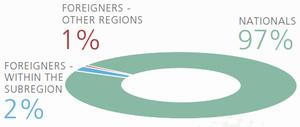
Source: UNODC elaboration on national data.
FIG. 62: Citizenships of offenders convicted in North Africa and the Middle East, 2010-2012

Source: UNODC elaboration on national data.
The subregion of North Africa and the Middle East reports the highest share of foreign involvement in trafficking in persons. Some 80 per cent of the persons convicted of trafficking in persons here are citizens of countries in other regions, mainly Asians. Just 11 per cent of the persons convicted in this subregion come from the country where they were convicted; a share that is largely made up of North Africans, rather than Middle Easterners.
This breakdown reflects the fact that the Middle East is mainly a destination of trafficking from Asia. This area experiences relatively limited intraregional trafficking, while limited domestic trafficking is detected.
Looking at the countries where citizens of countries in Africa and the Middle East have been convicted of trafficking in persons, there seems to be a relation with the cross-border trafficking flows of victims from this region. In Europe and Central Asia, some 9 per cent of the persons convicted are from Africa and the Middle East (6 per cent from Sub-Saharan Africa and 3 per cent from North Africa and the Middle East). Moreover, West African traffickers were detected in other parts of Africa, the Middle East and Europe. A limited number of Middle Eastern traffickers were detected in Europe and the Middle East
Profile of the victims
The two subregions also differ greatly in terms of the profiles of the detected victims. Sub-Saharan Africa reports the highest share of child trafficking in the world, and girls and boys are more or less equally detected. Trafficking in adults mainly targets women, as adult men comprise only 6 per cent of the total number of victims detected in Sub-Saharan Africa.
FIG. 63: Age and gender breakdown of victims detected in Africa and the Middle East, by subregion, 2010-2012
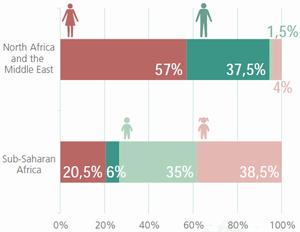
Source: UNODC elaboration on national data.
In North Africa and the Middle East, on the other hand, almost all detected victims (95 per cent) are adults. This is the largest share of adult victims of any region or sub-region. While most of the adults are women, at 55 per cent of the total, the share of males is large in a global perspective. Among the 5 per cent of victims who are children, more girls are detected than boys.
Almost one in five of the victims detected in Africa and the Middle East are trafficked for purposes other than sexual exploitation or forced labour. A major role is played by child soldiers in Sub-Saharan Africa, which particularly affects Central African conflict and post-conflict countries.
Trafficking flows
In terms of flows, domestic trafficking is the main type of trafficking in Sub-Saharan Africa. This type of trafficking accounts for more than three quarters of the total number of detected victims in this subregion, which is a very large proportion. Cross-border trafficking flows are normally of short range. Most West African victims are detected in West Africa, most Southern Africans in Southern African countries and so forth. Countries in Sub-Saharan Africa also detect a limited number of victims from other regions, especially East Asia, but these victims comprise a small share of the total number of detected victims.
As an origin area for trafficking out of the subregion, there are two significant outbound flows from Sub-Saharan Africa. One is bound for Western and Central Europe, and one for North Africa and the Middle East. These flows are largely comprised of West Africans trafficked to Western Europe, and East and West African victims detected in North Africa and the Middle East (most prominently in the Middle East).
West African victims have been detected in almost all Western European countries. The share of West African victims detected in Western Europe has remained constant for the last few years, and the flows are largely comprised of women and girls trafficked for sexual exploitation. Victims from East Africa are frequently detected in countries in the Middle East. During the reporting period, they accounted for some 10 per cent of total number of victims detected in that area.
FIG. 64: Origin of victims detected in Sub-Saharan Africa, shares of the total number of victims detected in the subregion, 2010-2012
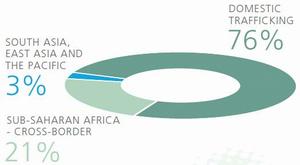
Source: UNODC elaboration on national data.
MAP 19: Destinations of trafficking victims originating in West Africa, proportion of the total number of detected victims at destinations, 2010-2012
Source: UNODC.
MAP 20: Destinations of trafficking victims originating in East Africa, proportion of the total number of detected victims at destinations, 2010-2012
Source: UNODC elaboration on national data.
MAP 21: Origins of victims trafficked to the Middle East, proportions of the total number of victims detected there, 2010-2012
Source: UNODC.
The Middle East is not only a destination for Sub-Saharan (mainly East) Africans. The region also experiences inbound trafficking from distant regions, especially from the region of South Asia, East Asia and the Pacific. It is not possible to single out one major area of origin; victims from a variety of countries in South-East Asia and the Indian sub-continent are trafficked mainly to the Gulf and other Middle Eastern countries.
Another significant inbound trafficking flow to the Middle East originates in Eastern Europe and Central Asia; a flow that comprises some 6 per cent of the victims detected in this subregion. This flow appears to be decreasing relatively rapidly. During the 2007-2010 period, these victims made up some 10 per cent of the total number of detected victims in North Africa and the Middle East, which is significantly higher than the 6 per cent share seen during the current reporting period.
Trafficking within the subregion accounts for some 30 per cent of the total number of victims, which is relatively low when compared to patterns recorded in other parts of the world, and lower than the number of victims from relatively distant East Asia and the Pacific. The share appears to be increasing, however, as the number of detected North African victims has grown in several countries in the Middle East. Domestic trafficking appears to be extremely limited in the Middle Eastern countries, while it is more relevant for the countries in North Africa.
This subregion is not a significant origin region for cross-border trafficking. Only Western and Central European countries report detecting small but significant numbers of victims from North Africa and the Middle East, about 2 per cent of the total number of victims detected there. Most of these victims are from North Africa.
Response to trafficking in persons
As reported in the global overview, the subregion of Sub-Saharan Africa is a part of the world where the lack of legislation is a key concern. Several countries still need to adopt legislation in line with the Trafficking in Persons Protocol more than ten years after its entry into force.
Nonetheless, significant improvements have been made in this subregion over the past decade. In 2003, 85 per cent of the countries in Sub-Saharan Africa lacked legislation on trafficking. Just two West African countries had comprehensive laws on trafficking in persons, and four had partial legislation that criminalized child trafficking only. After five years, in 2008, more than half of the countries still lacked a trafficking in persons crime in their legislation, while some more countries had introduced a child trafficking offence. Most of the efforts were concentrated between 2008 and 2012, and nowadays, 28 countries have legislation that is in line with the Trafficking in Persons Protocol. Still, more than 30 per cent of countries either have partial legislation or no specific offence at all.
MAP 22: Destinations of trafficking victims originating in North Africa, proportion of the total number of detected victims at destinations, 2010-2012
Source: UNODC.
As a result of the late introduction of proper legislation, most of the countries in this part of the world report very low numbers of convictions, and the number of countries where this information is not available or accessible is very high compared to the rest of the world. Only two countries, Togo and Nigeria, reported convictions of some 50 persons in at least one of the reporting years. The other countries either reported no convictions at all, or less than ten per year.
For North Africa and the Middle East, the situation in 2003 was similar to or worse than that of Sub-Saharan Africa. No country in North Africa and the Middle East had an offence that criminalized trafficking in persons as such. Only two countries had partial legislation (that focused on trafficking in children). Some improvements were reported in the first five years after the entry into force of the Trafficking in Persons Protocol, however, and by the year 2012 the majority of the countries in this sub-region had legislation that was in line with international standards.
FIG. 65: Historical evolution of the legislation in Sub Saharan Africa, 2003-2014
Source: UNODC elaboration on national data.
FIG. 66: Historical evolution of the legislation in North Africa and the Middle East, 2003-2014
Source: UNODC elaboration on national data.
Information on the criminal justice response is limited. Very few countries can provide data on the number of convictions, and when such figures are available, they are generally very low, with a couple of exceptions. About 40 per cent of the persons investigated for trafficking in persons in the United Arab Emirates are convicted in the first instance, and Israel reports a similar ratio. The lack of information for other countries does not permit similar analyses elsewhere.
[Source: United Nations Office on Drugs and Crime (UNODC), Vienna, Nov14]
Notes:
1. This conceptualization is reflected in the fact that the Protocol to Prevent, Suppress and Punish Trafficking in Persons, Especially Women and Children – which contains the main, international definition of the crime of trafficking in persons - supplements the United Nations Convention against Transnational Organized Crime. [Back]
2. "Organized criminal group" shall mean a structured group of three or more persons, existing for a period of time and acting in concert with the aim of committing one or more serious crimes or offences established in accordance with this Convention, in order to obtain, directly or indirectly, a financial or other material benefit." A/RES/55/25, the United Nations Convention against Transnational Organized Crime, Art. 2 (a). [Back]
3. For example, UNODC is starting to collect qualitative data on trafficking in persons through interviews with practitioners in select countries. The focus will be on offending, and this data will be used to further develop the typology. [Back]
4. A/RES/55/25 Annex II: The Protocol to Prevent, Suppress and Punish Trafficking in Persons, Especially Women and Children, supplementing the United Nations Convention against Transnational Organized Crime. [Back]
5. As of 15 August 2014. [Back]
7. Available at the Global Report website, http://www.unodc.org/glotip. [Back]
8. Available at the Global Report website, http://www.unodc.org/glotip. [Back]
9. Additionally, the UNODC Human Trafficking Case Law Database contains more than 1,000 case briefs from nearly 100 different jurisdictions. [Back]
11. This also includes flows where the country of origin and destination is the same, thus the case of domestic trafficking. [Back]
12. Including profile information on persons investigated for trafficking, or on the citizenships of those prosecuted for trafficking (as is done for the gender profile) would have yielded more data. However, using citizenship information only on offenders convicted in the first instance is more solid and limits possible biases related to the potential targeting of particular citizenships within some criminal justice systems. [Back]
13. United Nations Surveys on Crime Trends and the Operations of Criminal Justice Systems (CTS), available at: http://www.unodc.org/unodc/en/data-and-analysis/statistics/data.html. [Back]
14. For more information on the court cases, please refer to the section on Methodology. [Back]
15. United Nations Surveys on Crime Trends and the Operations of Criminal Justice Systems (CTS), available at: http://www.unodc.org/unodc/en/data-and-analysis/statistics/data.html. [Back]
16. UNODC, Global Report on Trafficking in Persons 2012 (United Nations publication, Sales No. E.13.V. 1). [Back]
17. For more details, see UNODC, Global Report on Trafficking in Persons 2012, pp 30-31. [Back]
18. See UNODC, Global Report on Trafficking in Persons 2012 and UNODC/UN.GIFT, Global Report on Trafficking in Persons, 2009. [Back]
19. Some countries in South America have legislation that is not fully in line with the UN Trafficking in Persons Protocol. Offences that may be prosecuted as trafficking for forced labour in countries with Protocol-compliant legislation may instead be prosecuted as crimes related to 'slavery and slavery-like conditions' in these countries. [Back]
20. The interpretative notes on article 3 of the Trafficking in Persons Protocol (see A/55/383/Add.1, paras. 63-68) indicate that illegal adoption is to be considered as a purpose of trafficking in persons where this amounts to a practice similar to slavery as defined in the Supplementary Convention on the Abolition of Slavery, the Slave Trade and Institutions and Practices Similar to Slavery (cited in the Travaux Preparatoires of the Negotiations for the Elaboration of the United Nations Convention against Transnational Organized Crime and the Protocols Thereto, p. 347). [Back]
21. See, for example, Surtees, R., Labour Trafficking in South-eastern Europe: Developing prevention and assistance programmes, NEXUS Institute to Combat Human Trafficking, 2007; and United Nations Inter-Agency Project on Human Trafficking (UNIAP), Recruitment Agencies and the Employment of Cambodian Domestic Workers in Malaysia, July 2011. [Back]
22. Defining a 'flow' as one origin country and one destination country with at least five detected victims during the 2010-2012 reporting period. This also includes the case of domestic trafficking in which the country of origin and destination coincide. [Back]
23. Transnationality is not a requirement for establishing a trafficking in persons offence. The Legislative Guides to the Trafficking in Persons Protocol (and the Convention against Transnational Organized Crime, which the Protocol supplements) state that 'It must be strongly emphasized that, while offences must involve transna-tionality and organized criminal groups for the Convention and its international cooperation provisions to apply, neither of these must be made elements of the domestic offence.' (UNODC, Legislative Guides for the implementation of the United Nations Convention against Organized Crime and the Protocols thereto, Section A, Implementation of the Protocol, Article 18.) Domestic trafficking in persons cases are reported by most of the countries that submit data to UNODC. [Back]
24. While the Middle East is part of the broader subregion of North Africa and the Middle East, the data from North Africa is extremely scarce. Therefore, the information on trafficking flows in this subre-gion refers near exclusively to the Middle East. [Back]
25. Verhoeven, M., et.al. (2013), 'Relationships between suspects and victims of sex trafficking. Exploitation of prostitutes and domestic violence parallel in Dutch trafficking cases,' European Journal of Criminal and Policy Research, 12 December 2013. [Back]
26. According to the United Nations Convention against Transnational Organized Crime, an organized crime group is understood to be a group of three or more persons, in existence for a period of time, acting in concert to commit at least one serious crime (punishable by at least four years of incarceration) in order to obtain financial or material benefit. [Back]
27. Zhang, S. X. (2012), Trafficking of Migrant Laborers in San Diego County: Looking for a Hidden Population, San Diego, CA: San Diego State University. [Back]
28. In Western and Central Europe, the share of the citizenships of the victims and of the offenders detected between 2010 and 2012 are correlated (pearsons coeff 0.828; sign 0.000). In Argentina, the same correlation is stronger (pearsons coeff 0.985; sign 0.000), and also confirmed in the United Arab Emirates (pearsons coeff 0.748; sign 0.000), . [Back]
29. The GDP per capita for these countries was: Japan: US$38, 492 (2013); Slovenia: $22,059 (2012); and Argentina: $14,760 (2013). (World Bank, World Development Indicators, GDP per capita in current US$). [Back]
30. See International Labour Office (ILO), LABORSTA database on wage statistics, available at: http://laborsta.ilo.org/STP/guest. [Back]
33. According to ILO LABORSTA (op.cit.), the average monthly pay for a laborer in the construction industry in Canada was around 2,000 euros per month for the period considered. [Back]
34. According to ILO LABORSTA, the monthly pay for a laborer in the Balkans for services in hotels and restaurants was around 220 euros per month for the period considered. [Back]
35. The share of the victims trafficked from outside of the region of detection for the period 2010-2012, and the GDP per capita for the year 2011 show a significant and strong positive correlation (pearsons coeff 0.729; sign 0.000). [Back]
36. An analysis of variance (ANOVA) among the shares of citizenships of foreign victims of trafficking detected at destination divided in two groups, victims from within the region and from outside the region, shows trafficking from within the region is more than three times higher than transregional trafficking. [Back]
37. Measured by the Composite Organized Crime Index (COCI) (Van Dijk, J., The World of Crime, Sage Publications, 2008, pp. 162-167) and the organized crime perception index referring to the year 2013 of the World Economic Forum (Schwab, K., The Global Competitiveness Report 2013–2014, World Economic Forum, 2013). [Back]
38. For Western and Central Europe, the share of the citizenships among victims of cross border trafficking for the period 2010-2012, and the Organized Crime Index COCI register a significant and positive correlation (pearsons coeff 0.577; sign 0.000), confirmed by using the World Economic Forum perception index 2013 (pearsons coeff -0.402; sign 0.000). For North and Central America, the share of the citizenships among victims of cross border trafficking from outside of the region for the period 2010-2012, and the Organized Crime Index COCI register a significant and positive correlation (pearsons coeff 0.379; sign 0.007), confirmed by using the World Economic Forum perception index 2013 (pearsons coeff -0.302; sign 0.014). When intraregional trafficking is considered this last one is stronger (pearsons coeff -0.742; sign 0.001). For the Middle East, the share of the citizenships among victims of cross border trafficking for the period 2010-2012, and the Organized Crime Index COCI registers a significant and positive correlation (pearsons coeff 0.564; sign 0.000), and it is much stronger if single regions of origin are considered. [Back]
39. 'TiP to N.Am': Origins of cross border trafficking detected in North and Central America and the Caribbean, in terms of share of victims detected by citizenship detected there. 'OCWEF' : Organized Crime Perception Index measured by the World Economic Forum in Schwab, K. The Global Competitiveness Report 2013–2014, World Economic Forum. Linear regression: Ln(TiP to N.Am)= -610*OCWEF-2.882. (Rsq. : 0.111; Sig.0.041; OCWEF Sig 0.041; Cost Sig 0.031). [Back]
40. 'TiP to Eu': Origins of cross border trafficking detected in Western and Central Europe, in terms of share of victims detected by citizenship detected there. COCI, Van Dijk, op. cit. Linear regression for intra-regional trafficking: Ln(TiP to Eu)= 0.075*COCI-11.304 - (Rsq. : 0.470; Sig: 0.000) - COCI (Sig 0.000); Cost (Sig 0.000). Linear regression for trans-regional trafficking: Ln(TiP to Eu)= 0.091*COCI-9.627 - (Rsq. : 0.435; Sig: 0.002) - COCI (Sig 0.002); Cost (Sig 0.000). [Back]
41. Stewart, J. Q., An inverse distance variation for certain social influences, Science, 93, 1941: 89-90. [Back]
42. Ibid; Haynes, K. E., and Fotheringham, A. S., Gravity and Spatial Interaction Models, Sage Publications, 1984. [Back]
43. 'TiP to Eu': Origins of cross border trafficking detected in Western and Central Europe, in terms of share of victims detected by citizenship detected there. 'COCI' : Composite Organized Crime Index measured by Van Dijk 2010. 'Dist to EU' : the geographical distance between the countries of origins and the geographical Centre of Western and Central Europe. 'Pop'; the population size of the countries considered; The multivariate regression for cross border trafficking is the following; Ln(TiP to Eu)= 0.656*COCI+0.3*Ln(POP)-0.624*Dist to EU. (Rsq. : 0.464; Sig: 0.000) - COCI (Sig 0.000); Dist to EU (Sig 0.000); POP (Sign 0.037); Cost (Sig 0.000). [Back]
44. UNODC/UN.GIFT, Global Report on Trafficking in Persons, 2009, p. 37. [Back]
45. UNODC, Global Report on Trafficking in Persons 2012, p. 85. [Back]
46. As the data coverage in this region is solid, it is possible to present more detailed analyses of the trafficking patterns and flows. In order to do so, the following geographical aggregations will be used in this section when appropriate: 'Western Europe' - Austria, Denmark, Finland, France, Germany, Ireland, the Netherlands, Norway, Sweden, Switzerland and the United Kingdom; 'Southern Europe' - Cyprus, Greece, Italy, Malta, Portugal, Spain and Turkey; 'Central Europe' - Czech Republic, Estonia, Hungary, Latvia, Lithuania, Poland, Slovakia and Slovenia; and 'the Balkans' - Albania, Bosnia and Herzegovina, Bulgaria, Croatia, Montenegro, Romania, Serbia and the Former Yugoslav Republic of Macedonia. [Back]
47. For more information on the court cases, please refer to the section on Methodology. [Back]
48. For this analysis, 15 countries that are more typical origin than destination countries for cross-border trafficking have been considered. [Back]
Bookshop Donate
Radio Nizkor
Corruption and organized crime
This document has been published on 03Nov15 by the Equipo Nizkor and Derechos Human Rights. In accordance with Title 17 U.S.C. Section 107, this material is distributed without profit to those who have expressed a prior interest in receiving the included information for research and educational purposes.